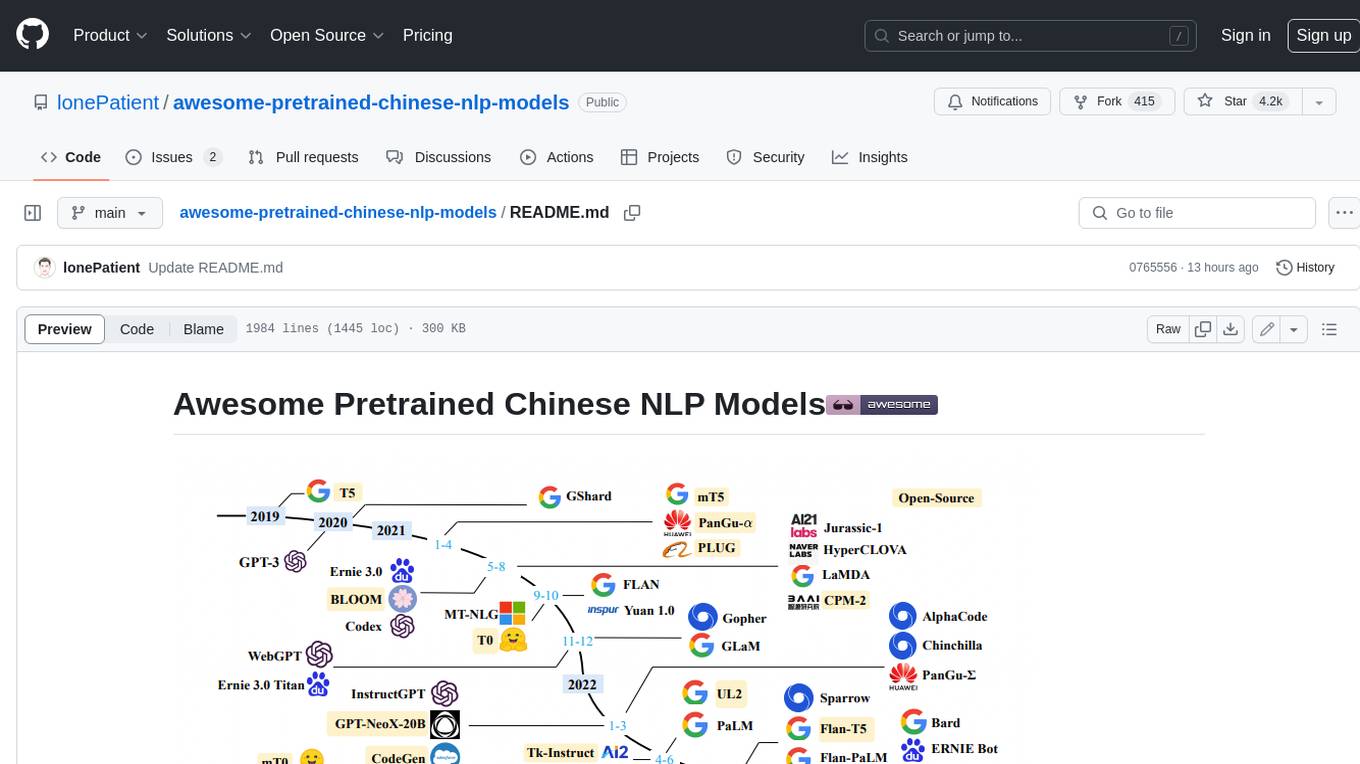
DeepSparkHub
DeepSparkHub selects hundreds of application algorithms and models, covering various fields of AI and general-purpose computing, to support the mainstream intelligent computing scenarios. This repository is the mirror of Gitee.
Stars: 67
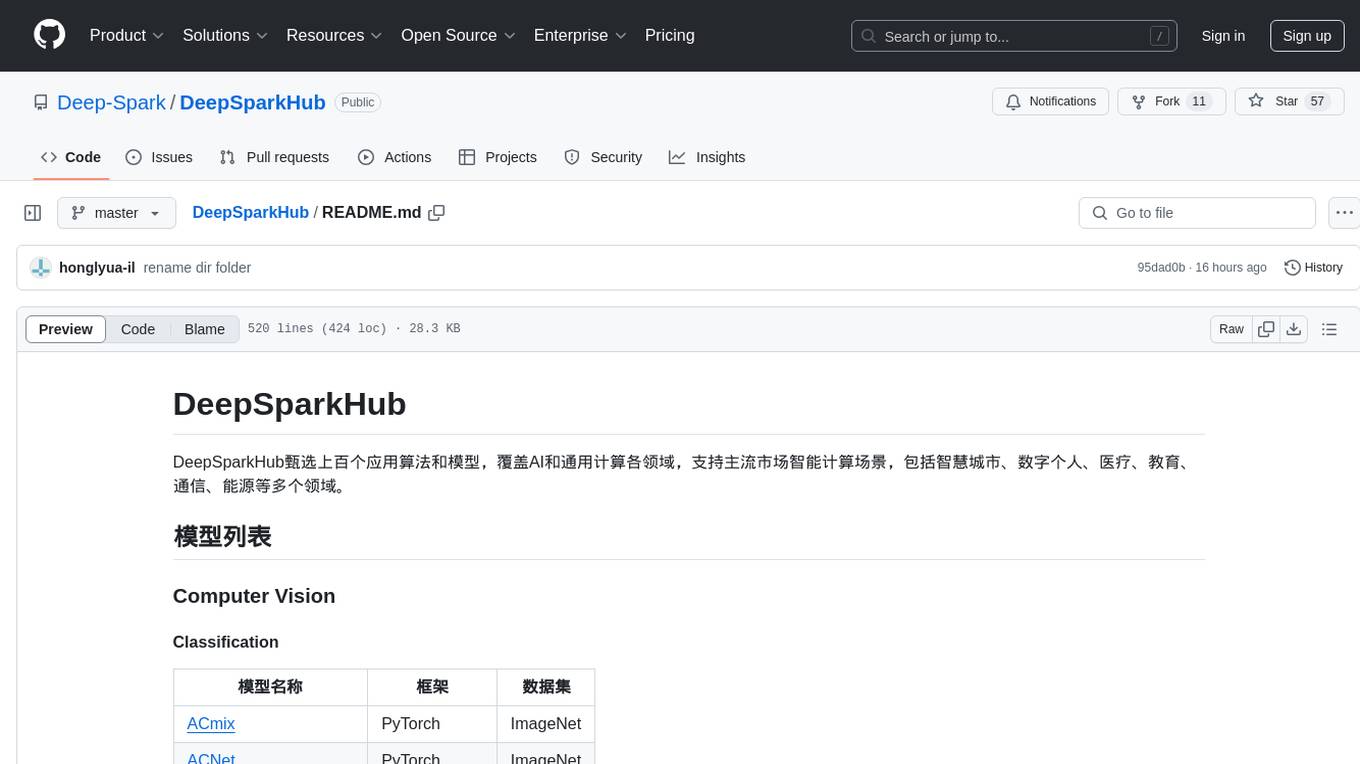
DeepSparkHub is a repository that curates hundreds of application algorithms and models covering various fields in AI and general computing. It supports mainstream intelligent computing scenarios in markets such as smart cities, digital individuals, healthcare, education, communication, energy, and more. The repository provides a wide range of models for tasks such as computer vision, face detection, face recognition, instance segmentation, image generation, knowledge distillation, network pruning, object detection, 3D object detection, OCR, pose estimation, self-supervised learning, semantic segmentation, super resolution, tracking, traffic forecast, GNN, HPC, methodology, multimodal, NLP, recommendation, reinforcement learning, speech recognition, speech synthesis, and 3D reconstruction.
README:
DeepSparkHub甄选上百个应用算法和模型,覆盖AI和通用计算各领域,支持主流市场智能计算场景,包括智慧城市、数字个人、医疗、教育、通信、能源等多个领域。
| Model | Framework | ToolBox | Dataset/Weight | IXUCA SDK |
|---|---|---|---|---|
| Aquila2-34B | PyTorch | Megatron-DeepSpeed | Bookcorpus | 3.4.0 |
| Baichuan2-7B | PyTorch | DeepSpeed | baichuan2-7b-base | 3.4.0 |
| Bloom-7B1 | PyTorch | Firefly | school_math_0.25M | 3.4.0 |
| ChatGLM-6B | PyTorch | DeepSpeed | ADGEN & chatglm-6b | 3.1.0 |
| ChatGLM2-6B SFT | PyTorch | DeepSpeed | ADGEN & chatglm2-6b | 3.4.0 |
| ChatGLM3-6B | PyTorch | DeepSpeed | ADGEN & chatglm3-6b | 4.1.1 |
| DeepSeekMoE 7B | PyTorch | ColossalAI | deepseek-moe-16b-base | 4.1.1 |
| DeepSeek-LLM-7B | PyTorch | verl | deepseek-llm-7b-chat | 4.4.0 |
| GLM-4 | PyTorch | Torchrun | glm-4-9b-chat | 4.2.0 |
| Gemma-2-2B-IT | PyTorch | verl | gemma-2-2b-it | 4.4.0 |
| Llama-7B | PyTorch | ColossalAI | llama-7b-hf | 3.1.0 |
| Llama2-7B | PyTorch | Megatron-DeepSpeed | Bookcorpus | 3.1.0 |
| Llama2-7B RMF | PyTorch | DeepSpeed | Dahoas/rm-static | 3.1.1 |
| Llama2-7B RLHF | PyTorch | Megatron-DeepSpeed | llama2-7b&tiny-llama | 3.4.0 |
| Llama2-7B SFT | PyTorch | Megatron-DeepSpeed | GPT Small-117M | 3.1.1 |
| Llama2-13B | PyTorch | Megatron-DeepSpeed | Bookcorpus | 3.4.0 |
| Llama2-34B | PyTorch | Megatron-DeepSpeed | Bookcorpus | 3.4.0 |
| Llama3-8B | PyTorch | Megatron-DeepSpeed | Bookcorpus | 4.1.1 |
| Llama3-8B | PyTorch | Megatron-LM | GPT Small-117M | 4.3.0 |
| Llama3-8B SFT | PyTorch | ColossalAI | school_math_0.25M | 4.1.1 |
| Llama3-8B SFT | PyTorch | OpenRLHF | Meta-Llama-3-8B | 4.3.0 |
| Llama3-8B PPO | PyTorch | OpenRLHF | Llama-3-8b-sft-mixture | 4.2.0 |
| Llama3-8B DPO | PyTorch | OpenRLHF | Llama-3-8b-sft-mixture | 4.2.0 |
| Llama3-8B KTO | PyTorch | OpenRLHF | Llama-3-8b-sft-mixture | 4.2.0 |
| Mamba-2 | PyTorch | Megatron-LM | GPT Small-117M | 4.1.1 |
| MiniCPM | PyTorch | DeepSpeed | MiniCPM-2B-sft-bf16 | 4.2.0 |
| Mixtral 8x7B | PyTorch | Megatron-LM | GPT Small-117M | 4.1.1 |
| Mixtral 8x7B | PyTorch | OpenRLHF | Mixtral-8x7B-v0.1 | 4.3.0 |
| Phi-3 | PyTorch | Torchrun | Phi-3-mini-4k-instruct | 4.2.0 |
| QWen-7B | PyTorch | Firefly | qwen-7b | 3.4.0 |
| QWen1.5-7B | PyTorch | Firefly | school_math | 4.1.1 |
| QWen1.5-14B | PyTorch | Firefly | school_math | 4.1.1 |
| Qwen2-7B | PyTorch | verl | qwen2-7b | 4.4.0 |
| Qwen2.5-7B SFT | PyTorch | LLaMA-Factory | qwen2.5-7b | 4.1.1 |
| Qwen2.5-1.5B verl | PyTorch | verl | qwen2.5-1.5b | 4.2.0 |
| Qwen2.5-7B verl | PyTorch | verl | qwen2.5-7b | 4.2.0 |
| Qwen2.5-3B | PyTorch | ColossalAI | qwen2.5-3b | 4.3.0 |
| Qwen2.5-VL-7B | PyTorch | verl | qwen2.5-vl-7b | 4.4.0 |
| Qwen3-8B | PyTorch | verl | qwen3-8b | 4.4.0 |
| Yi-6B | PyTorch | DeepSpeed | Yi-6B | 4.2.0 |
| Yi-1.5-6B | PyTorch | DeepSpeed | Yi-1.5-6B | 4.2.0 |
| Yi-VL-6B | PyTorch | LLaMA-Factory | Yi-VL-6B-hf | 4.2.0 |
| Model | Framework | Dataset | IXUCA SDK |
|---|---|---|---|
| ACmix | PyTorch | ImageNet | 2.2.0 |
| ACNet | PyTorch | ImageNet | 3.1.0 |
| AlexNet | PyTorch | ImageNet | 2.2.0 |
| AlexNet | TensorFlow | ImageNet | 3.1.0 |
| BYOL | PyTorch | ImageNet | 3.1.0 |
| CBAM | PyTorch | ImageNet | 3.0.0 |
| ConvNext | PyTorch | ImageNet | 2.2.0 |
| CspDarknet53 | PyTorch | ImageNet | 3.0.0 |
| DenseNet | PaddlePaddle | ImageNet | 3.1.0 |
| DenseNet | PyTorch | ImageNet | 2.2.0 |
| DPN92 | PyTorch | ImageNet | 2.2.0 |
| DPN107 | PyTorch | ImageNet | 2.2.0 |
| ECA-MobileNetV2 | PyTorch | ImageNet | 2.2.0 |
| ECA-ResNet152 | PyTorch | ImageNet | 2.2.0 |
| EfficientNetB0 | PaddlePaddle | ImageNet | 3.1.0 |
| EfficientNetB4 | PyTorch | ImageNet | 2.2.0 |
| FasterNet | PyTorch | ImageNet | 3.0.0 |
| GoogLeNet | PyTorch | ImageNet | 2.2.0 |
| GoogLeNet | PaddlePaddle | ImageNet | 2.3.0 |
| InceptionV3 | MindSpore | ImageNet | 3.1.0 |
| InceptionV3 | PyTorch | ImageNet | 2.2.0 |
| InceptionV3 | TensorFlow | ImageNet | 3.1.0 |
| InceptionV4 | PyTorch | ImageNet | 2.2.0 |
| InternImage | PyTorch | ImageNet | 3.1.0 |
| LeNet | PyTorch | ImageNet | 2.2.0 |
| MobileNetV2 | PyTorch | ImageNet | 2.2.0 |
| MobileNetV3 | MindSpore | ImageNet | 3.1.0 |
| MobileNetV3 | PyTorch | ImageNet | 2.2.0 |
| MobileNetV3 | PaddlePaddle | ImageNet | 2.3.0 |
| MobileNetV3_Large1.0 | PaddlePaddle | ImageNet | 3.1.0 |
| MobileOne | PyTorch | ImageNet | 3.1.0 |
| MoCoV2 | PyTorch | ImageNet | 3.1.0 |
| PP-LCNet | PaddlePaddle | ImageNet | 3.1.0 |
| RepMLP | PyTorch | ImageNet | 3.1.0 |
| RepVGG | PyTorch | ImageNet | 3.0.0 |
| RepVGG | PaddlePaddle | ImageNet | 3.0.0 |
| RepViT | PyTorch | ImageNet | 3.1.0 |
| Res2Net50_14w_8s | PaddlePaddle | ImageNet | 3.1.0 |
| ResNeSt14 | PyTorch | ImageNet | 2.2.0 |
| ResNeSt50 | PyTorch | ImageNet | 2.2.0 |
| ResNeSt50 | PaddlePaddle | ImageNet | 3.0.0 |
| ResNeSt101 | PyTorch | ImageNet | 2.2.0 |
| ResNeSt269 | PyTorch | ImageNet | 2.2.0 |
| ResNet18 | PyTorch | ImageNet | 2.2.0 |
| ResNet50 | PyTorch | ImageNet | 2.2.0 |
| ResNet50 | PaddlePaddle | ImageNet | 2.3.0 |
| ResNet50 | TensorFlow | ImageNet | 3.0.0 |
| ResNet101 | PyTorch | ImageNet | 2.2.0 |
| ResNet152 | PyTorch | ImageNet | 2.2.0 |
| ResNeXt50_32x4d | MindSpore | ImageNet | 3.1.0 |
| ResNeXt50_32x4d | PyTorch | ImageNet | 2.2.0 |
| ResNeXt101_32x8d | PyTorch | ImageNet | 2.2.0 |
| SE_ResNet50_vd | PaddlePaddle | ImageNet | 3.1.0 |
| SEResNeXt | PyTorch | ImageNet | 2.2.0 |
| ShuffleNetV2 | PaddlePaddle | ImageNet | 3.1.0 |
| ShuffleNetV2 | PyTorch | ImageNet | 2.2.0 |
| SqueezeNet | PyTorch | ImageNet | 2.2.0 |
| Swin Transformer | PaddlePaddle | ImageNet | 3.0.0 |
| Swin Transformer | PyTorch | ImageNet | 2.2.0 |
| VGG16 | PaddlePaddle | ImageNet | 2.3.0 |
| VGG16 | PyTorch | ImageNet | 2.2.0 |
| VGG16 | TensorFlow | ImageNet | 3.1.0 |
| Wave-MLP | PyTorch | ImageNet | 2.2.0 |
| Wide_ResNet101_2 | PyTorch | ImageNet | 2.2.0 |
| Xception | PaddlePaddle | ImageNet | 3.1.0 |
| Xception | PyTorch | ImageNet | 2.2.0 |
| Model | Framework | Dataset | IXUCA SDK |
|---|---|---|---|
| RetinaFace | PyTorch | WIDER FACE | 3.0.0 |
| Model | Framework | Dataset | IXUCA SDK |
|---|---|---|---|
| ArcFace | PyTorch | CASIA-WebFaces&LFW | 3.0.0 |
| BlazeFace | PaddlePaddle | WIDER FACE | 3.1.0 |
| CosFace | PyTorch | CASIA-WebFaces&LFW | 3.0.0 |
| FaceNet | PyTorch | CASIA-WebFaces&LFW | 3.0.0 |
| FaceNet | TensorFlow | CASIA-WebFaces&LFW | 3.1.0 |
| Model | Framework | Dataset | IXUCA SDK |
|---|---|---|---|
| SOLO | PyTorch | COCO | 3.0.0 |
| SOLOv2 | PaddlePaddle | COCO | 3.0.0 |
| SOLOv2 | PyTorch | COCO | 3.1.0 |
| YOLACT++ | PyTorch | COCO | 3.0.0 |
| Model | Framework | Dataset | IXUCA SDK |
|---|---|---|---|
| DCGAN | MindSpore | ImageNet | 3.0.0 |
| Pix2Pix | PaddlePaddle | facades | 3.1.0 |
| Model | Framework | Dataset | IXUCA SDK |
|---|---|---|---|
| CWD | PyTorch | Cityscapes | 3.0.0 |
| RKD | PyTorch | CUB-200-2011 | 3.0.0 |
| WSLD | PyTorch | ImageNet | 3.1.0 |
| Model | Framework | Dataset | IXUCA SDK |
|---|---|---|---|
| ATSS | PyTorch (MMDetection) | COCO | 3.0.0 |
| AutoAssign | PyTorch | COCO | 2.2.0 |
| Cascade R-CNN | PyTorch (MMDetection) | COCO | 3.0.0 |
| CenterMask2 | PyTorch | COCO | 4.1.1 |
| CenterNet | PyTorch | COCO | 2.2.0 |
| CenterNet | PaddlePaddle | COCO | 3.0.0 |
| Co-DETR | PyTorch | COCO | 3.1.0 |
| CornerNet | PyTorch (MMDetection) | COCO | 3.0.0 |
| DCNV2 | PyTorch (MMDetection) | COCO | 3.0.0 |
| DETR | PaddlePaddle | COCO | 3.0.0 |
| Faster R-CNN | PyTorch | COCO | 2.2.0 |
| FCOS | PaddlePaddle | COCO | 3.0.0 |
| FCOS | PyTorch | COCO | 3.0.0 |
| Mamba-YOLO | PyTorch | COCO | 4.1.1 |
| Mask R-CNN | PyTorch | COCO | 2.2.0 |
| Mask R-CNN | PaddlePaddle | COCO | 2.3.0 |
| OC_SORT | PaddlePaddle | MOT17 | 3.1.0 |
| Oriented RepPoints | PyTorch | DOTA | 3.1.0 |
| PP-PicoDet | PaddlePaddle | COCO | 3.1.0 |
| PP-YOLOE | PaddlePaddle | COCO | 2.3.0 |
| PP-YOLOE+ | PaddlePaddle | COCO | 3.1.1 |
| PVANet | PyTorch | COCO | 2.2.0 |
| RepPoints | PyTorch (MMDetection) | COCO | 3.0.0 |
| RetinaNet | PyTorch | COCO | 2.2.0 |
| RetinaNet | PaddlePaddle | COCO | 3.0.0 |
| RT-DETR | PyTorch | COCO | 4.1.1 |
| RTMDet | PyTorch | COCO | 3.1.0 |
| SSD | PyTorch | COCO | 2.2.0 |
| SSD | PaddlePaddle | COCO | 2.3.0 |
| SSD | TensorFlow | VOC | 3.0.0 |
| SSD | MindSpore | COCO | 3.0.0 |
| YOLOF | PyTorch | COCO | 2.2.0 |
| YOLOv3 | PyTorch | COCO | 2.2.0 |
| YOLOv3 | PaddlePaddle | COCO | 2.3.0 |
| YOLOv3 | TensorFlow | VOC | 3.0.0 |
| YOLOv5 | PaddlePaddle | COCO | 3.1.1 |
| YOLOv5 | PyTorch | COCO | 2.2.0 |
| YOLOv6 | PyTorch | COCO | 3.0.0 |
| YOLOv7 | PyTorch | COCO | 3.0.0 |
| YOLOv8 | PyTorch | COCO | 3.0.0 |
| YOLOv9 | PyTorch | COCO | 4.1.1 |
| YOLOv10 | PyTorch | COCO | 4.1.1 |
| YOLOv11 | PyTorch | COCO | 4.2.0 |
| Model | Framework | Dataset | IXUCA SDK |
|---|---|---|---|
| BEVFormer | PyTorch | nuScenes&CAN bus | 3.0.0 |
| CenterPoint | PyTorch | nuScenes | 3.1.1 |
| PAConv | PyTorch | S3DIS | 3.1.1 |
| Part-A2-Anchor | PyTorch | KITTI | 4.1.1 |
| Part-A2-Free | PyTorch | KITTI | 4.1.1 |
| PointNet++ | PyTorch | S3DIS | 3.0.0 |
| PointPillars | PyTorch | KITTI | 3.0.0 |
| PointRCNN | PyTorch | KITTI | 3.1.1 |
| PointRCNN-IoU | PyTorch | KITTI | 4.1.1 |
| SECOND | PyTorch | KITTI | 4.1.1 |
| SECOND-IoU | PyTorch | KITTI | 4.1.1 |
| Model | Framework | Dataset | IXUCA SDK |
|---|---|---|---|
| HashNeRF | PyTorch | fox | 2.2.0 |
| Model | Framework | Dataset | IXUCA SDK |
|---|---|---|---|
| GAT | PaddlePaddle | CORA | 3.1.0 |
| GCN | MindSpore | CORA & Citeseer | 3.0.0 |
| GCN | PaddlePaddle | CORA & PubMed & Citeseer | 3.1.0 |
| GraphSAGE | PaddlePaddle | 3.1.0 |
| Model | Framework | Dataset | IXUCA SDK |
|---|---|---|---|
| CRNN | MindSpore | OCR_Recog | 3.1.0 |
| CRNN | PaddlePaddle | LMDB | 2.3.0 |
| DBNet | PyTorch | ICDAR2015 | 3.0.0 |
| DBNet++ | PaddlePaddle | ICDAR2015 | 3.1.1 |
| DBNet++ | PyTorch | ICDAR2015 | 3.1.0 |
| PP-OCR-DB | PaddlePaddle | ICDAR2015 | 2.3.0 |
| PP-OCR-EAST | PaddlePaddle | ICDAR2015 | 3.1.1 |
| PSE | PaddlePaddle | OCR_Recog | 2.3.0 |
| SAR | PyTorch | OCR_Recog | 2.2.0 |
| SAST | PaddlePaddle | ICDAR2015 | 3.1.1 |
| SATRN | PyTorch | OCR_Recog | 2.2.0 |
| Model | Framework | Dataset | IXUCA SDK |
|---|---|---|---|
| Point-BERT | PyTorch | ShapeNet55 & processed ModelNet | 2.2.0 |
| Model | Framework | Dataset | IXUCA SDK |
|---|---|---|---|
| AlphaPose | PyTorch | COCO | 3.0.0 |
| HRNet | PyTorch | COCO | 2.2.0 |
| HRNet-W32 | PaddlePaddle | COCO | 3.1.0 |
| OpenPose | MindSpore | COCO | 3.1.0 |
| Model | Framework | Dataset | IXUCA SDK |
|---|---|---|---|
| MAE | PyTorch | ImageNet | 3.0.0 |
| Model | Framework | Dataset | IXUCA SDK |
|---|---|---|---|
| 3D-UNet | PyTorch | kits19 | 2.2.0 |
| APCNet | PyTorch | Cityscapes | 2.2.0 |
| Attention U-net | PyTorch | Cityscapes | 3.0.0 |
| BiSeNet | PyTorch | COCO | 2.2.0 |
| BiSeNetV2 | PaddlePaddle | Cityscapes | 3.0.0 |
| BiSeNetV2 | PyTorch | Cityscapes | 3.1.1 |
| CGNet | PyTorch | COCO | 2.2.0 |
| ContextNet | PyTorch | COCO | 2.2.0 |
| DabNet | PyTorch | COCO | 2.2.0 |
| DANet | PyTorch | COCO | 2.2.0 |
| DDRnet | PyTorch | Cityscapes | 3.0.0 |
| DeepLabV3 | PyTorch | COCO | 2.2.0 |
| DeepLabV3 | PaddlePaddle | Cityscapes | 2.3.0 |
| DeepLabV3 | MindSpore | VOC | 3.0.0 |
| DeepLabV3+ | PaddlePaddle | Cityscapes | 3.0.0 |
| DeepLabV3+ | TensorFlow | Cityscapes | 3.1.0 |
| DenseASPP | PyTorch | COCO | 2.2.0 |
| DFANet | PyTorch | COCO | 2.2.0 |
| DNLNet | PaddlePaddle | Cityscapes | 2.3.0 |
| DUNet | PyTorch | COCO | 2.2.0 |
| EncNet | PyTorch | COCO | 2.2.0 |
| ENet | PyTorch | COCO | 2.2.0 |
| ERFNet | PyTorch | COCO | 2.2.0 |
| ESPNet | PyTorch | COCO | 2.2.0 |
| FastFCN | PyTorch | ADE20K | 3.1.0 |
| FastSCNN | PyTorch | COCO | 2.2.0 |
| FCN | PyTorch | COCO | 2.2.0 |
| FPENet | PyTorch | COCO | 2.2.0 |
| GCNet | PyTorch | Cityscapes | 2.2.0 |
| HardNet | PyTorch | COCO | 2.2.0 |
| ICNet | PyTorch | COCO | 2.2.0 |
| LedNet | PyTorch | COCO | 2.2.0 |
| LinkNet | PyTorch | COCO | 2.2.0 |
| Mask2Former | PyTorch | Cityscapes | 3.1.0 |
| MobileSeg | PaddlePaddle | Cityscapes | 3.1.0 |
| OCNet | PyTorch | COCO | 2.2.0 |
| OCRNet | PaddlePaddle | Cityscapes | 3.1.0 |
| OCRNet | PyTorch | Cityscapes | 2.2.0 |
| PP-HumanSegV1 | PaddlePaddle | PP-HumanSeg14K | 3.1.0 |
| PP-HumanSegV2 | PaddlePaddle | PP-HumanSeg14K | 3.1.0 |
| PP-LiteSeg | PaddlePaddle | Cityscapes | 3.1.0 |
| PSANet | PyTorch | COCO | 2.2.0 |
| PSPNet | PyTorch | Cityscapes | 2.2.0 |
| RefineNet | PyTorch | COCO | 2.2.0 |
| SegNet | PyTorch | COCO | 2.2.0 |
| STDC | PaddlePaddle | Cityscapes | 3.1.0 |
| STDC | PyTorch | Cityscapes | 3.0.0 |
| UNet | PyTorch | COCO | 2.2.0 |
| UNet | PaddlePaddle | Cityscapes | 2.3.0 |
| UNet++ | PyTorch | DRIVE | 3.0.0 |
| VNet | TensorFlow | Hippocampus | 3.0.0 |
| Model | Framework | Dataset | IXUCA SDK |
|---|---|---|---|
| basicVSR++ | PyTorch | REDS | 2.2.0 |
| basicVSR | PyTorch | REDS | 2.2.0 |
| ESRGAN | PyTorch | DIV2K | 2.2.0 |
| LIIF | PyTorch | DIV2K | 2.2.0 |
| RealBasicVSR | PyTorch | REDS | 2.2.0 |
| TTSR | PyTorch | CUFED | 2.2.0 |
| TTVSR | PyTorch | REDS | 2.2.0 |
| Model | Framework | Dataset | IXUCA SDK |
|---|---|---|---|
| ByteTrack | PaddlePaddle | MOT17 | 3.1.0 |
| DeepSORT | PyTorch | Market-1501 | 3.0.0 |
| FairMOT | PyTorch | MOT17 | 2.2.0 |
| Model | Framework | Dataset | IXUCA SDK |
|---|---|---|---|
| BLIP | PyTorch | COCO | 3.1.1 |
| CLIP | PyTorch | CIFAR100 | 2.2.0 |
| ControlNet | PyTorch | Fill50K | 3.1.0 |
| DDPM | PyTorch | CIFAR-10 | 3.1.0 |
| LLaVA 1.5 | PyTorch | LLaVA-Pretrain | 4.1.1 |
| L-Verse | PyTorch | ImageNet | 2.2.0 |
| MoE-LLaVA-Phi2-2.7B | PyTorch | MoE-LLaVA | 4.2.0 |
| MoE-LLaVA-Qwen-1.8B | PyTorch | MoE-LLaVA | 4.2.0 |
| MoE-LLaVA-StableLM-1.6B | PyTorch | MoE-LLaVA | 4.2.0 |
| Stable Diffusion 1.4 | PyTorch | pokemon-images | 3.0.0 |
| Stable Diffusion 1.5 | PyTorch | pokemon-images | 4.1.1 |
| Stable Diffusion 2.1 | PyTorch | pokemon-images | 4.1.1 |
| Stable Diffusion 3 | PyTorch | dog-example | 4.1.1 |
| Stable Diffusion XL | PyTorch | pokemon-images | 4.1.1 |
| Model | Framework | Dataset | IXUCA SDK |
|---|---|---|---|
| GLM | PyTorch | GLMForMultiTokenCloze | 2.2.0 |
| Model | Framework | Dataset | IXUCA SDK |
|---|---|---|---|
| CPM | PyTorch | STC | 2.2.0 |
| Model | Framework | Dataset | IXUCA SDK |
|---|---|---|---|
| BART | PyTorch (Fairseq) | RTE | 3.0.0 |
| BERT NER | PyTorch | CoNLL-2003 | 3.0.0 |
| BERT Pretraining | PyTorch | MLCommon Wikipedia | 2.2.0 |
| BERT Pretraining | PaddlePaddle | MNLI | 2.3.0 |
| BERT Pretraining | TensorFlow | MNLI | 3.0.0 |
| BERT Pretraining | MindSpore | SQuAD | 3.0.0 |
| BERT Text Classification | PyTorch | GLUE | 3.0.0 |
| BERT Text Summerization | PyTorch | cnn_dailymail | 3.0.0 |
| BERT Question Answering | PyTorch | SQuAD | 3.0.0 |
| GPT2-Medium-EN | PaddlePaddle | SST-2 | 3.1.0 |
| RoBERTa | PyTorch (Fairseq) | RTE | 3.0.0 |
| XLNet | PaddlePaddle | SST-2 | 3.1.0 |
| Model | Framework | Dataset | IXUCA SDK |
|---|---|---|---|
| ERNIE | PaddlePaddle | corpus | 2.3.0 |
| Model | Framework | Dataset | IXUCA SDK |
|---|---|---|---|
| Convolutional | PyTorch (Fairseq) | WMT14 | 3.0.0 |
| T5 | PyTorch | WMT14 | 2.2.0 |
| Transformer | PaddlePaddle | WMT14 | 2.3.0 |
| Transformer | PyTorch (Fairseq) | IWSLT14 | 3.0.0 |
| Model | Framework | Dataset | IXUCA SDK |
|---|---|---|---|
| DQN | PaddlePaddle | CartPole-v0 | 3.1.0 |
| Model | Framework | Dataset | IXUCA SDK |
|---|---|---|---|
| Conformer | PyTorch (WeNet) | AISHELL | 2.2.0 |
| Efficient Conformer v2 | PyTorch (WeNet) | AISHELL | 3.1.0 |
| PP-ASR-Conformer | PaddlePaddle | AISHELL | 3.1.0 |
| RNN-T | PyTorch | LJSpeech | 2.2.0 |
| Transformer | PyTorch (WeNet) | AISHELL | 3.0.0 |
| U2++ Conformer | PyTorch (WeNet) | AISHELL | 3.0.0 |
| Unified Conformer | PyTorch (WeNet) | AISHELL | 3.0.0 |
| Model | Framework | Dataset | IXUCA SDK |
|---|---|---|---|
| CosyVoice2-0.5B | DeepSpeed | openslr | 4.3.0 |
| PP-TTS-FastSpeech2 | PaddlePaddle | CSMSC | 3.1.0 |
| PP-TTS-HiFiGAN | PaddlePaddle | CSMSC | 3.1.0 |
| Tacotron2 | PyTorch | LJSpeech | 2.2.0 |
| VQMIVC | PyTorch | VCTK-Corpus | 2.2.0 |
| WaveGlow | PyTorch | LJSpeech | 2.2.0 |
| Model | Framework | Dataset | IXUCA SDK |
|---|---|---|---|
| Graph WaveNet | PyTorch | METR-LA & PEMS-BAY | 2.2.0 |
| Model | Framework | Dataset | IXUCA SDK |
|---|---|---|---|
| KAN | PyTorch | - | 4.1.1 |
| Model | Framework | Dataset | IXUCA SDK |
|---|---|---|---|
| Network Slimming | PyTorch | CIFAR-10/100 | 3.0.0 |
| Model | Framework | Dataset | IXUCA SDK |
|---|---|---|---|
| DeepFM | PaddlePaddle | Criteo_Terabyte | 2.3.0 |
| DLRM | PyTorch | Criteo_Terabyte | 2.2.0 |
| DLRM | PaddlePaddle | Criteo_Terabyte | 3.1.0 |
| FFM | PaddlePaddle | Criteo_Terabyte | 3.1.0 |
| NCF | PyTorch | movielens | 2.2.0 |
| Wide&Deep | PaddlePaddle | Criteo_Terabyte | 2.3.0 |
| xDeepFM | PaddlePaddle | Criteo_Terabyte | 3.1.0 |
请参见 DeepSpark Code of Conduct on Gitee or on GitHub。
请联系 [email protected]。
请参见 DeepSparkHub Contributing Guidelines。
DeepSparkHub仅提供公共数据集的下载和预处理脚本。这些数据集不属于DeepSparkHub,DeepSparkHub也不对其质量或维护负责。请确保 您具有这些数据集的使用许可,基于这些数据集训练的模型仅可用于非商业研究和教育。
致数据集所有者:
如果不希望您的数据集公布在DeepSparkHub上或希望更新DeepSparkHub中属于您的数据集,请在Gitee或Github上提交issue,我们将按您 的issue删除或更新。衷心感谢您对我们社区的支持和贡献。
本项目许可证遵循Apache-2.0。
For Tasks:
Click tags to check more tools for each tasksFor Jobs:
Alternative AI tools for DeepSparkHub
Similar Open Source Tools

DeepSparkHub
DeepSparkHub is a repository that curates hundreds of application algorithms and models covering various fields in AI and general computing. It supports mainstream intelligent computing scenarios in markets such as smart cities, digital individuals, healthcare, education, communication, energy, and more. The repository provides a wide range of models for tasks such as computer vision, face detection, face recognition, instance segmentation, image generation, knowledge distillation, network pruning, object detection, 3D object detection, OCR, pose estimation, self-supervised learning, semantic segmentation, super resolution, tracking, traffic forecast, GNN, HPC, methodology, multimodal, NLP, recommendation, reinforcement learning, speech recognition, speech synthesis, and 3D reconstruction.
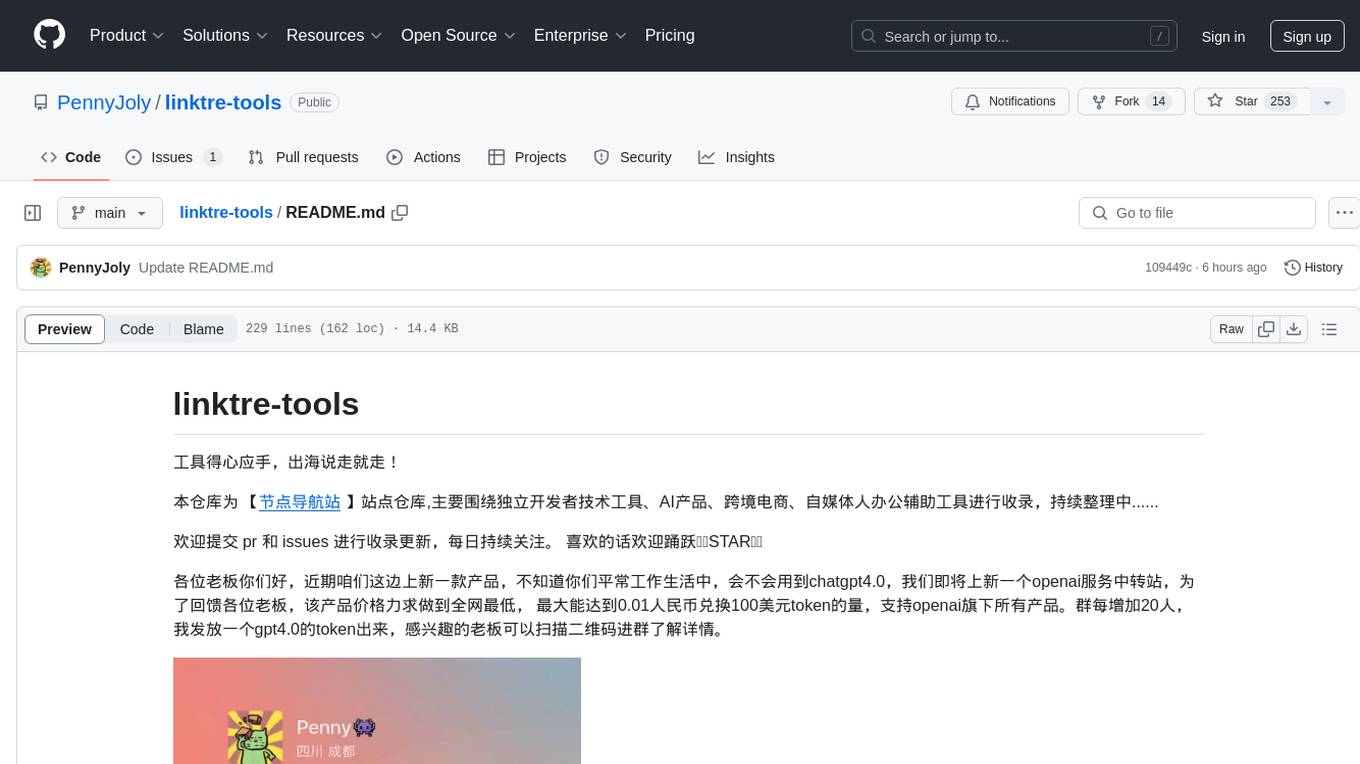
linktre-tools
The 'linktre-tools' repository is a collection of tools and resources for independent developers, AI products, cross-border e-commerce, and self-media office assistance. It aims to provide a curated list of tools and products in these areas. Users are encouraged to contribute by submitting pull requests and raising issues for continuous updates. The repository covers a wide range of topics including AI tools, independent development tools, popular AI products, tools for web development, online tools, media operations, and cross-border e-commerce resources.
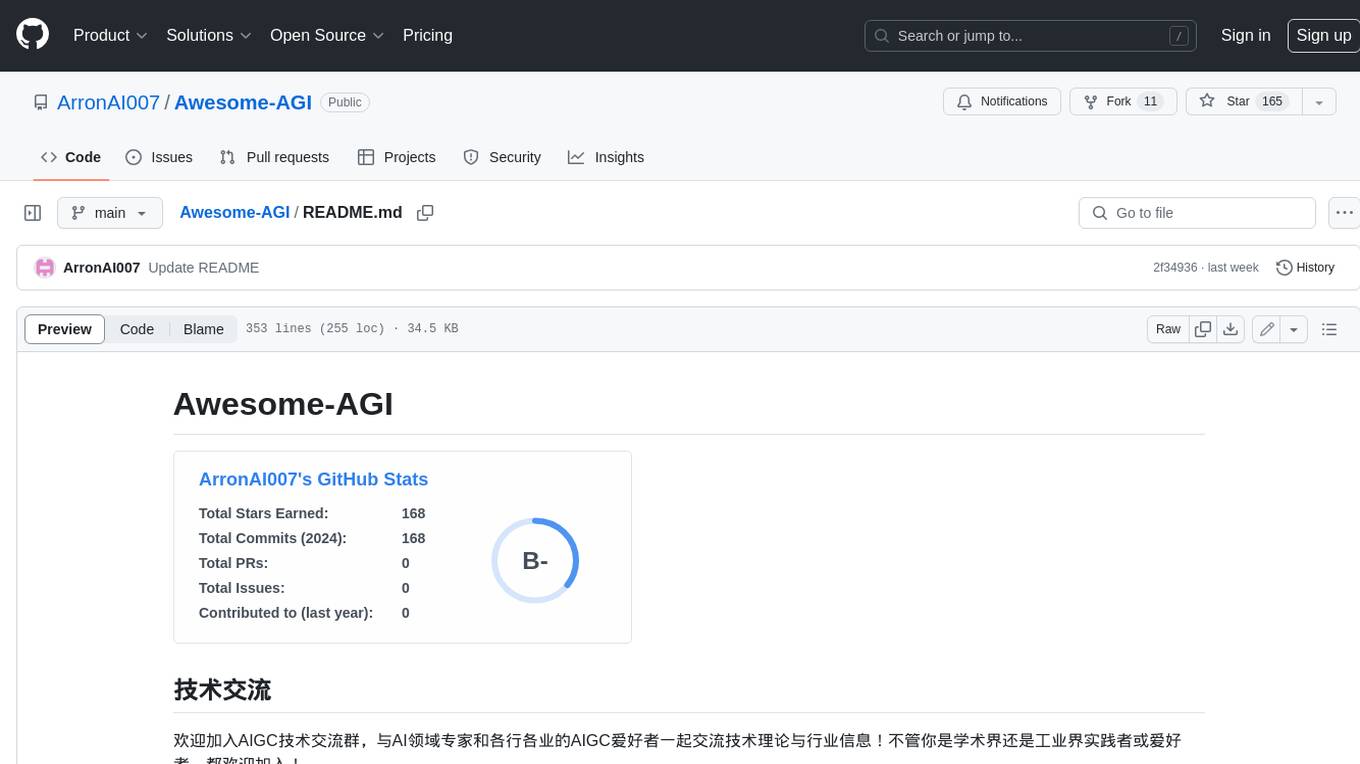
Awesome-AGI
Awesome-AGI is a curated list of resources related to Artificial General Intelligence (AGI), including models, pipelines, applications, and concepts. It provides a comprehensive overview of the current state of AGI research and development, covering various aspects such as model training, fine-tuning, deployment, and applications in different domains. The repository also includes resources on prompt engineering, RLHF, LLM vocabulary expansion, long text generation, hallucination mitigation, controllability and safety, and text detection. It serves as a valuable resource for researchers, practitioners, and anyone interested in the field of AGI.
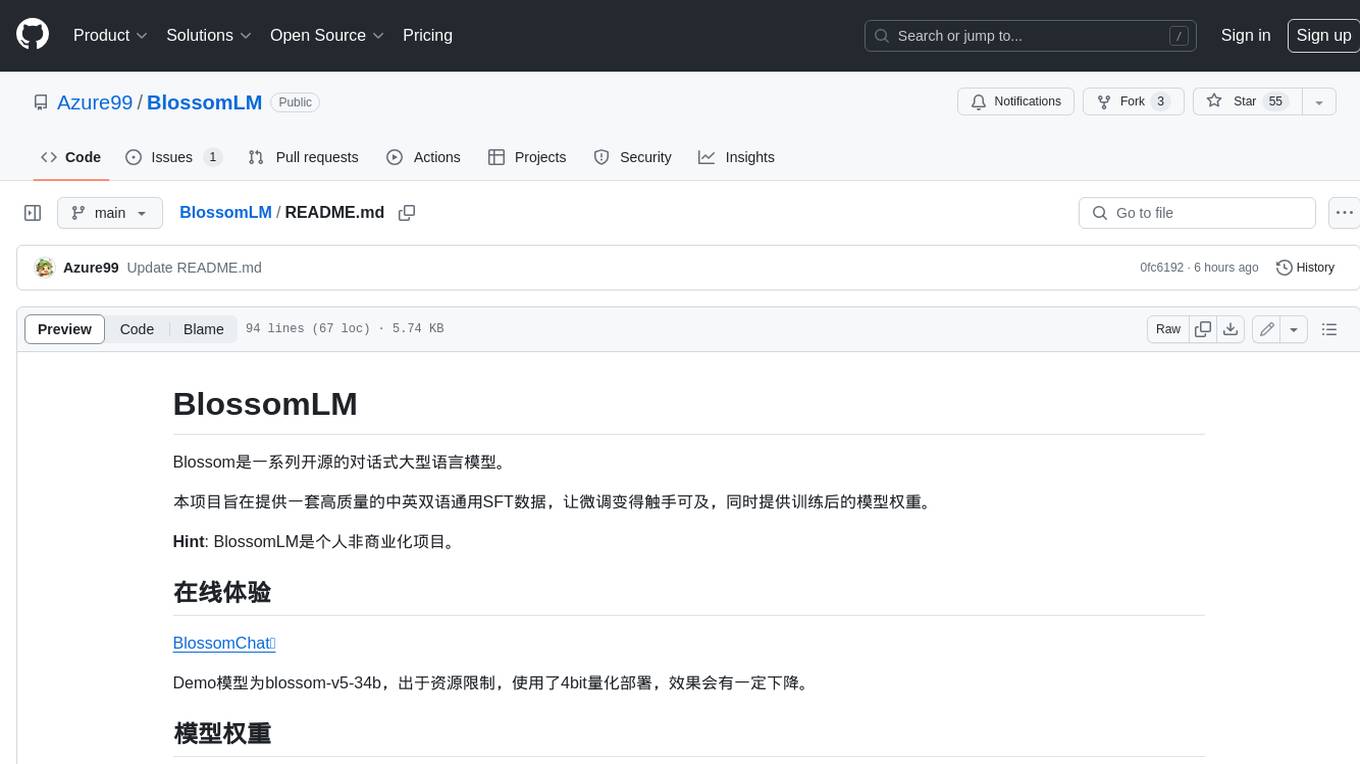
BlossomLM
BlossomLM is a series of open-source conversational large language models. This project aims to provide a high-quality general-purpose SFT dataset in both Chinese and English, making fine-tuning accessible while also providing pre-trained model weights. **Hint**: BlossomLM is a personal non-commercial project.
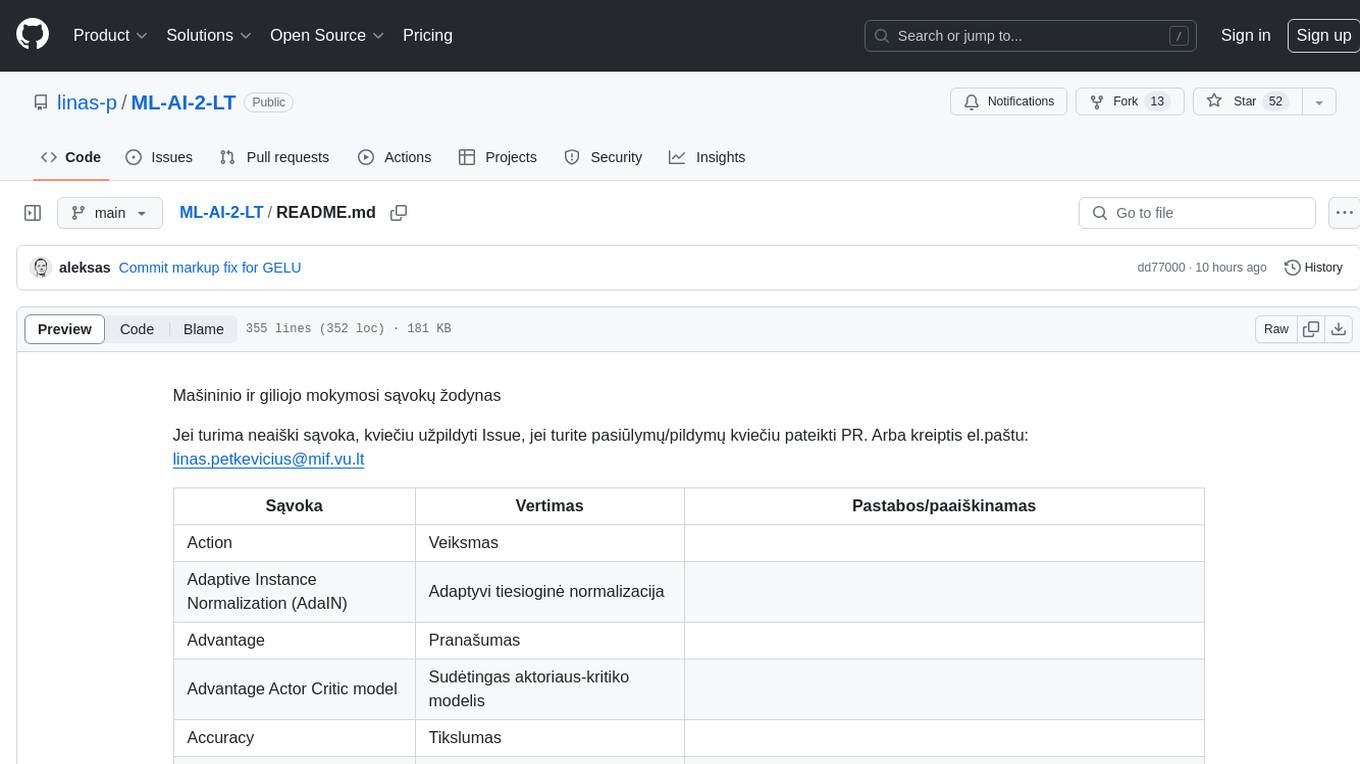
ML-AI-2-LT
ML-AI-2-LT is a repository that serves as a glossary for machine learning and deep learning concepts. It contains translations and explanations of various terms related to artificial intelligence, including definitions and notes. Users can contribute by filling issues for unclear concepts or by submitting pull requests with suggestions or additions. The repository aims to provide a comprehensive resource for understanding key terminology in the field of AI and machine learning.
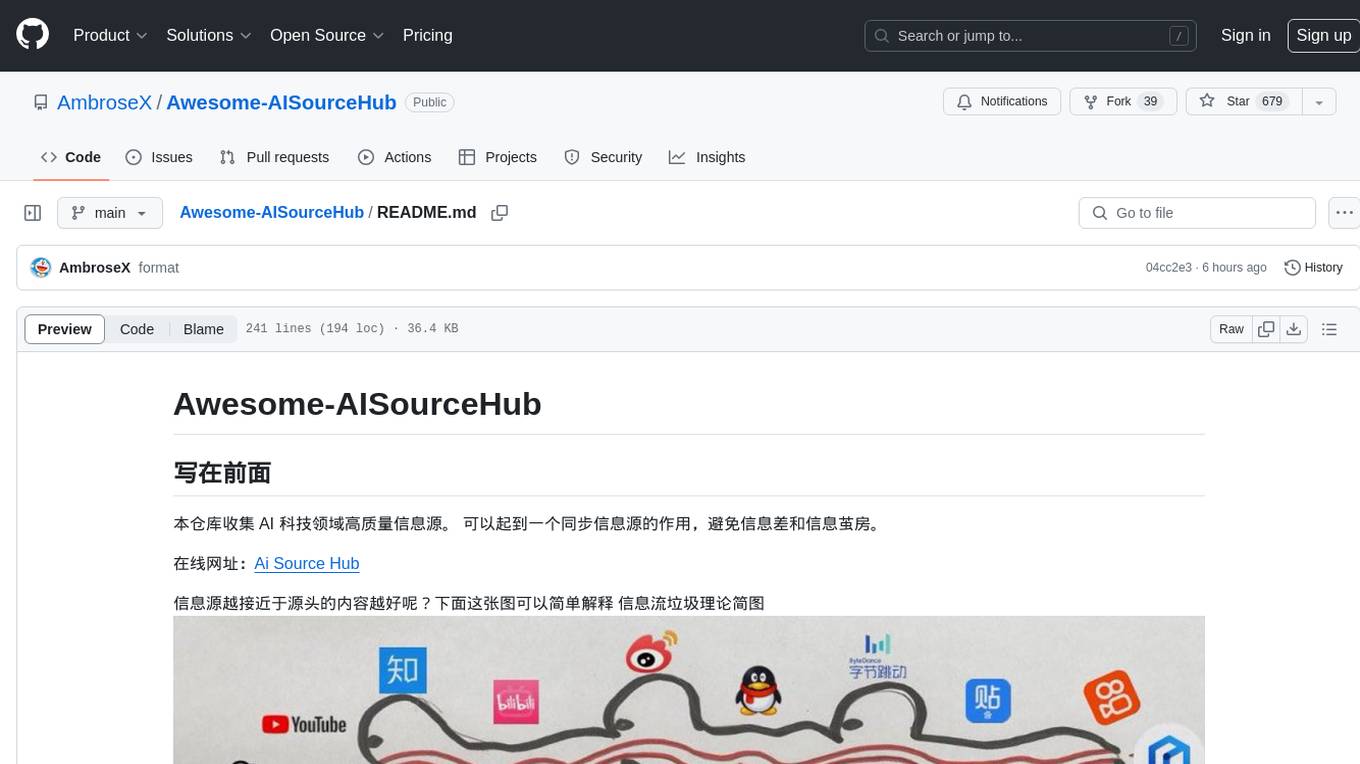
Awesome-AISourceHub
Awesome-AISourceHub is a repository that collects high-quality information sources in the field of AI technology. It serves as a synchronized source of information to avoid information gaps and information silos. The repository aims to provide valuable resources for individuals such as AI book authors, enterprise decision-makers, and tool developers who frequently use Twitter to share insights and updates related to AI advancements. The platform emphasizes the importance of accessing information closer to the source for better quality content. Users can contribute their own high-quality information sources to the repository by following specific steps outlined in the contribution guidelines. The repository covers various platforms such as Twitter, public accounts, knowledge planets, podcasts, blogs, websites, YouTube channels, and more, offering a comprehensive collection of AI-related resources for individuals interested in staying updated with the latest trends and developments in the AI field.
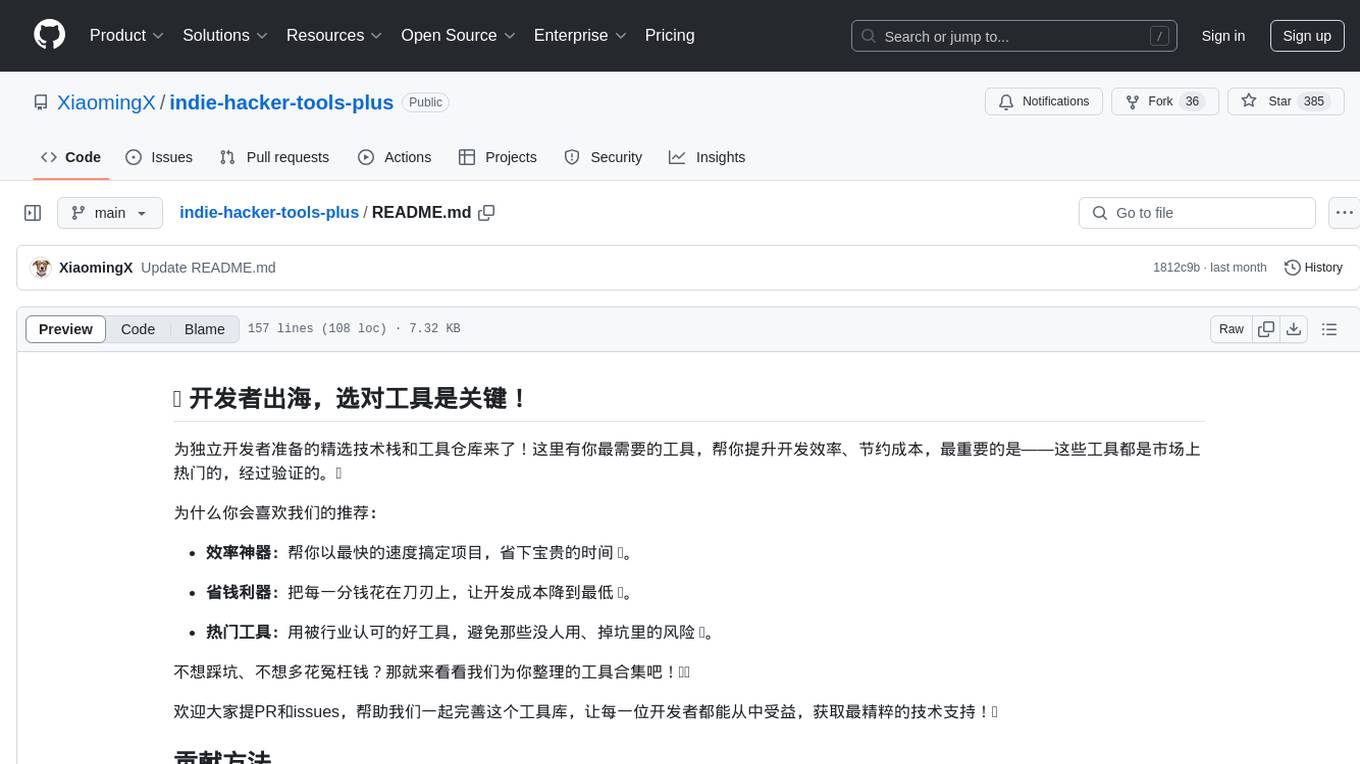
indie-hacker-tools-plus
Indie Hacker Tools Plus is a curated repository of essential tools and technology stacks for independent developers. The repository aims to help developers enhance efficiency, save costs, and mitigate risks by using popular and validated tools. It provides a collection of tools recognized by the industry to empower developers with the most refined technical support. Developers can contribute by submitting articles, software, or resources through issues or pull requests.
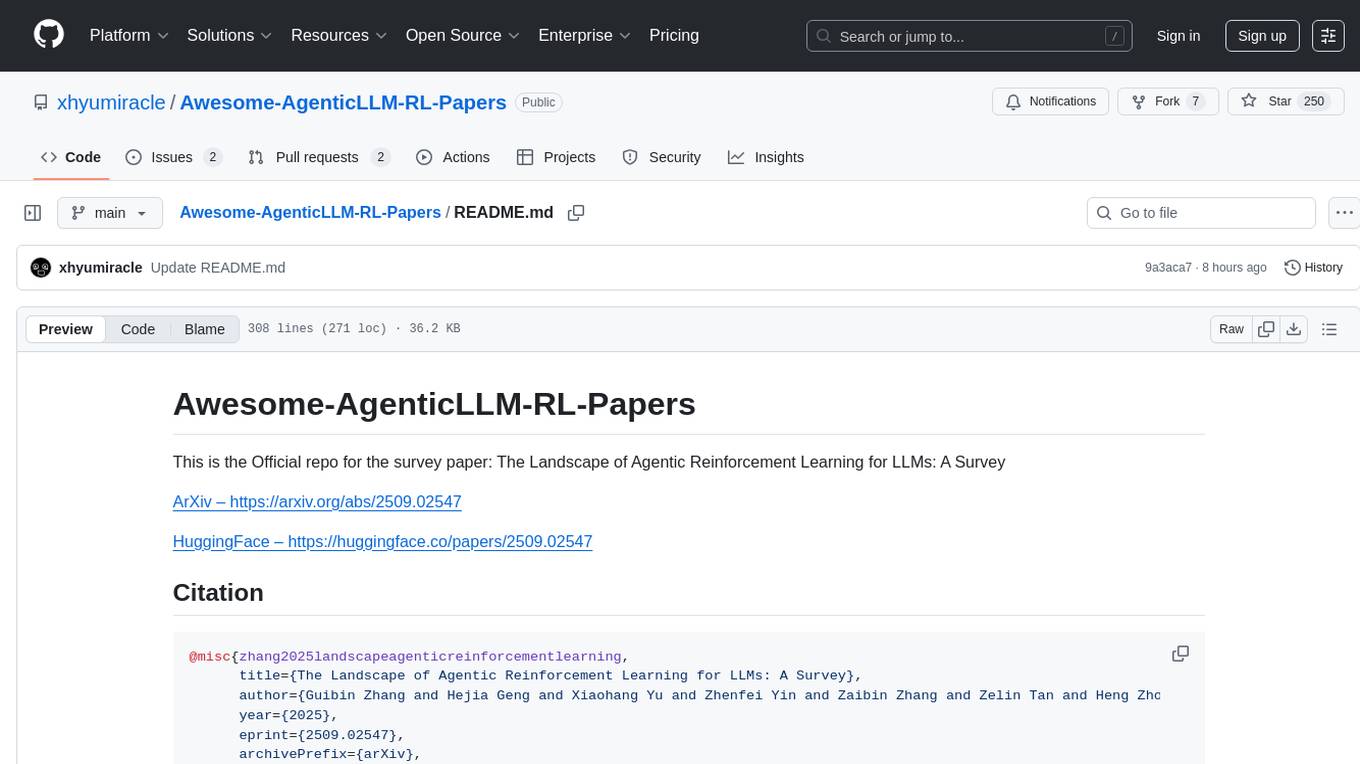
Awesome-AgenticLLM-RL-Papers
This repository serves as the official source for the survey paper 'The Landscape of Agentic Reinforcement Learning for LLMs: A Survey'. It provides an extensive overview of various algorithms, methods, and frameworks related to Agentic RL, including detailed information on different families of algorithms, their key mechanisms, objectives, and links to relevant papers and resources. The repository covers a wide range of tasks such as Search & Research Agent, Code Agent, Mathematical Agent, GUI Agent, RL in Vision Agents, RL in Embodied Agents, and RL in Multi-Agent Systems. Additionally, it includes information on environments, frameworks, and methods suitable for different tasks related to Agentic RL and LLMs.
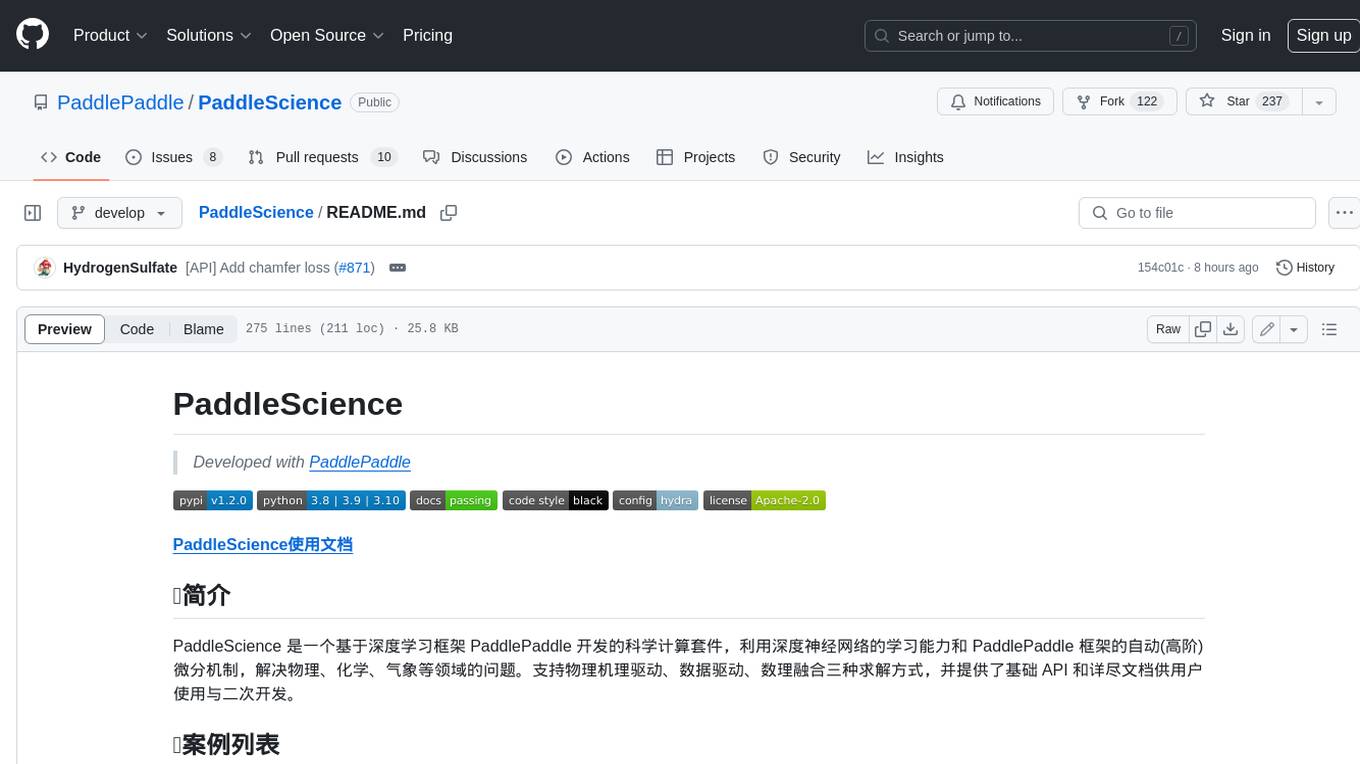
PaddleScience
PaddleScience is a scientific computing suite developed based on the deep learning framework PaddlePaddle. It utilizes the learning ability of deep neural networks and the automatic (higher-order) differentiation mechanism of PaddlePaddle to solve problems in physics, chemistry, meteorology, and other fields. It supports three solving methods: physics mechanism-driven, data-driven, and mathematical fusion, and provides basic APIs and detailed documentation for users to use and further develop.
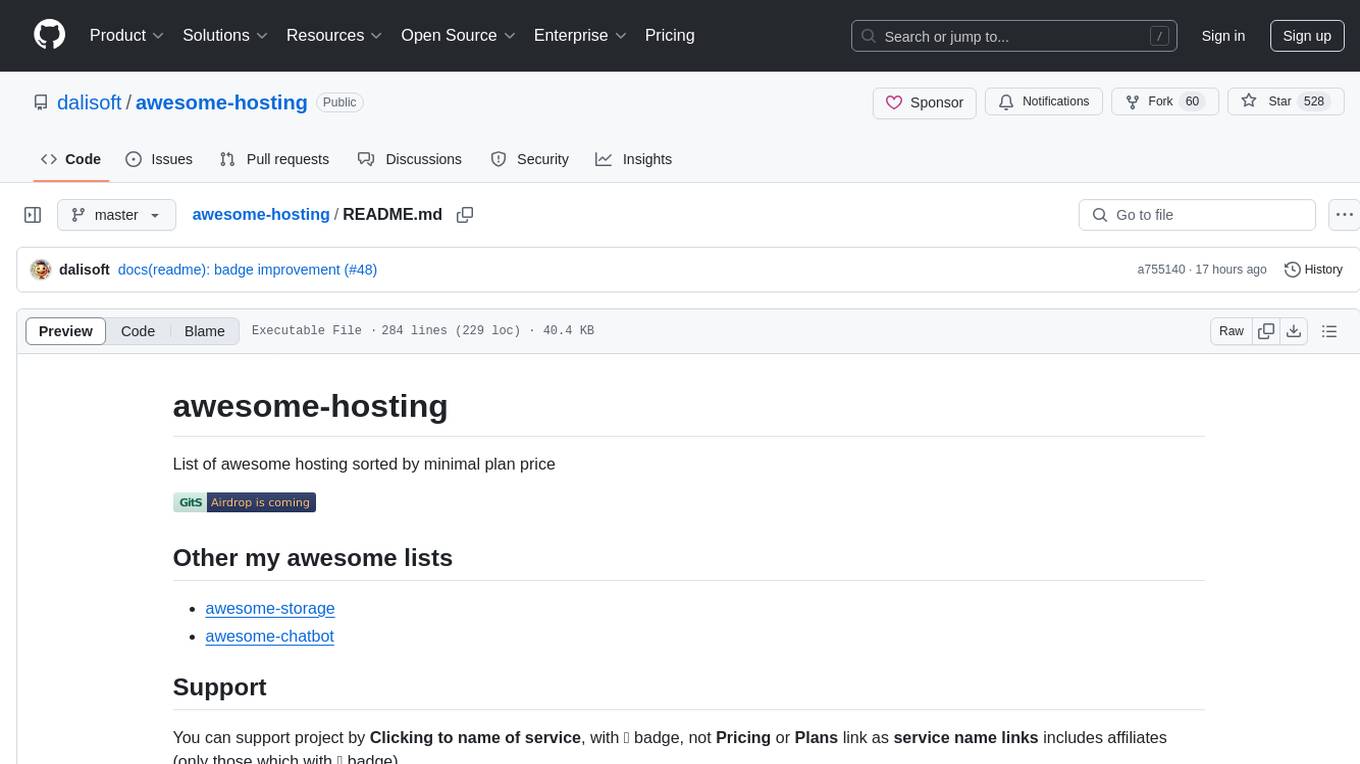
awesome-hosting
awesome-hosting is a curated list of hosting services sorted by minimal plan price. It includes various categories such as Web Services Platform, Backend-as-a-Service, Lambda, Node.js, Static site hosting, WordPress hosting, VPS providers, managed databases, GPU cloud services, and LLM/Inference API providers. Each category lists multiple service providers along with details on their minimal plan, trial options, free tier availability, open-source support, and specific features. The repository aims to help users find suitable hosting solutions based on their budget and requirements.
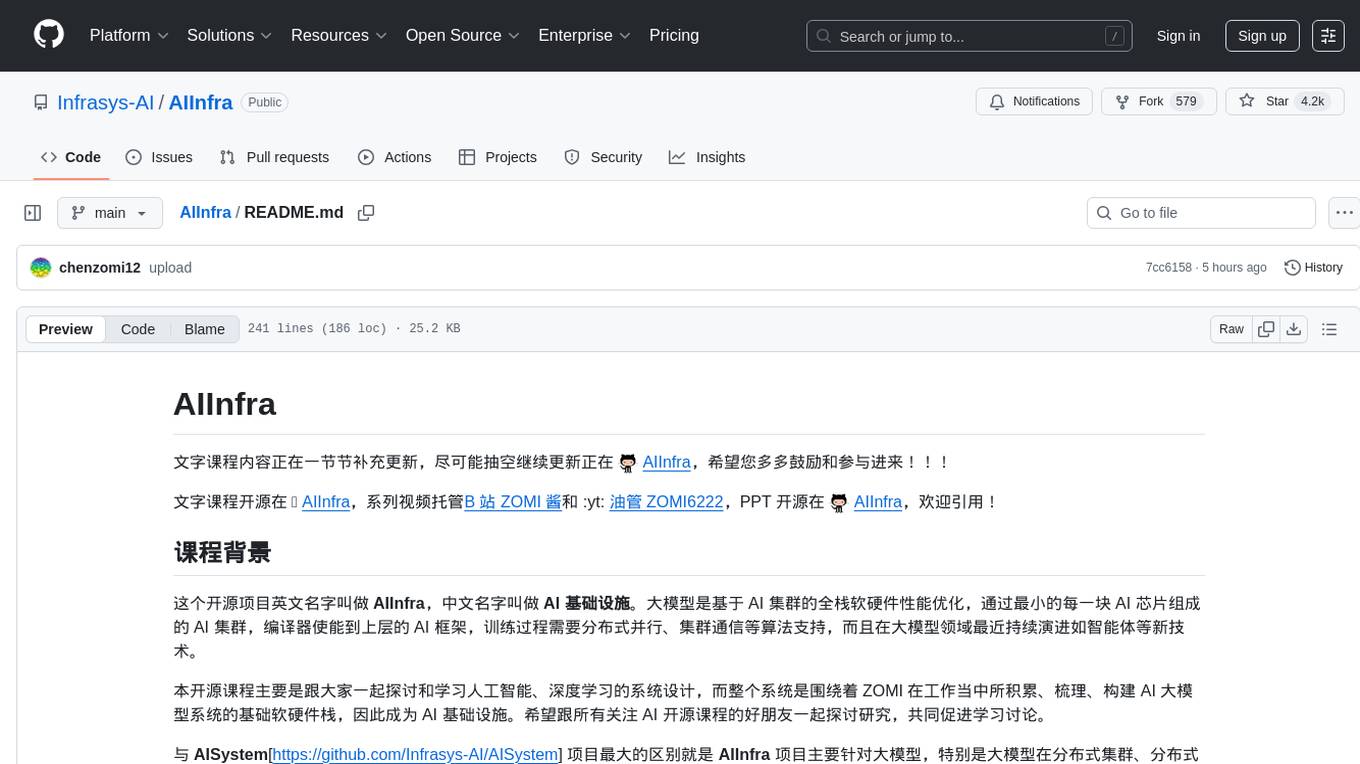
AIInfra
AIInfra is an open-source project focused on AI infrastructure, specifically targeting large models in distributed clusters, distributed architecture, distributed training, and algorithms related to large models. The project aims to explore and study system design in artificial intelligence and deep learning, with a focus on the hardware and software stack for building AI large model systems. It provides a comprehensive curriculum covering key topics such as system overview, AI computing clusters, communication and storage, cluster containers and cloud-native technologies, distributed training, distributed inference, large model algorithms and data, and applications of large models.
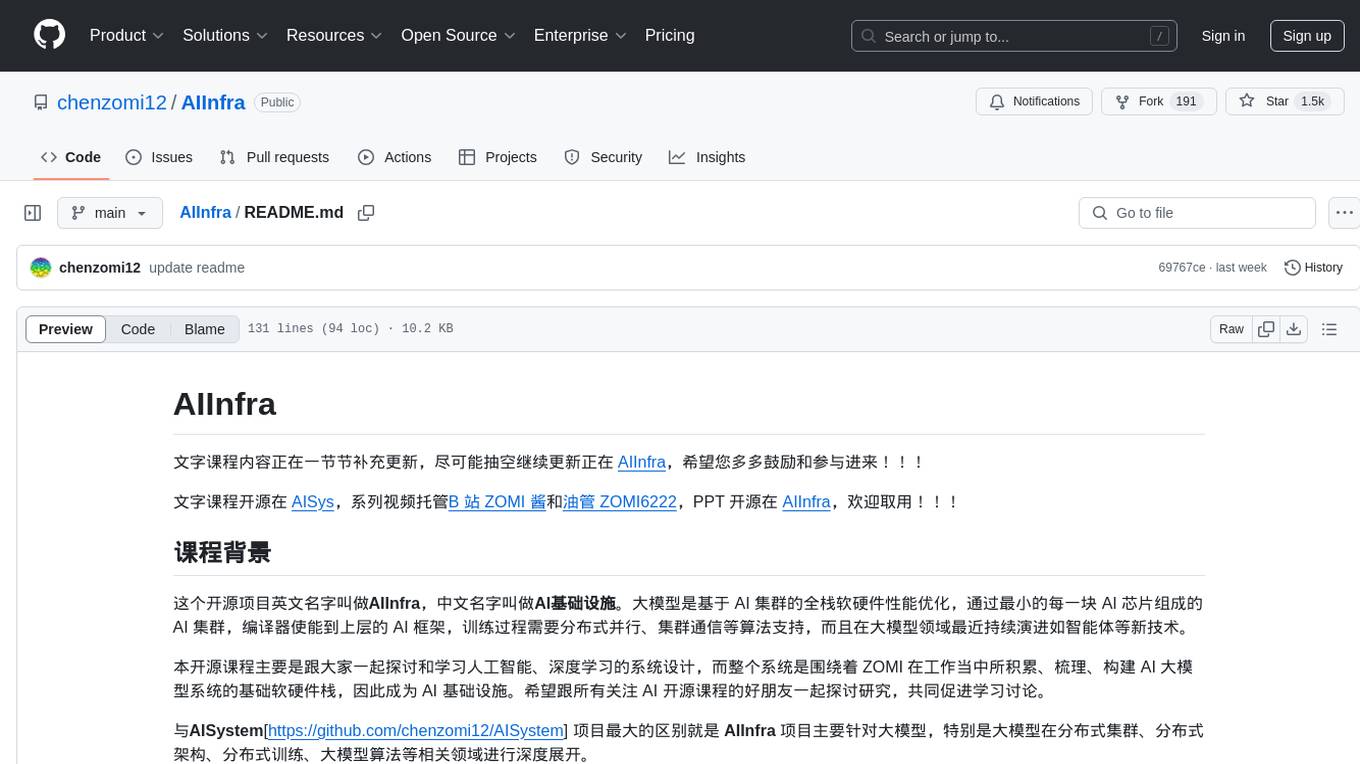
AIInfra
AIInfra is an open-source project focused on AI infrastructure, specifically targeting large models in distributed clusters, distributed architecture, distributed training, and algorithms related to large models. The project aims to explore and study system design in artificial intelligence and deep learning, with a focus on the hardware and software stack for building AI large model systems. It provides a comprehensive curriculum covering topics such as AI chip principles, communication and storage, AI clusters, large model training, and inference, as well as algorithms for large models. The course is designed for undergraduate and graduate students, as well as professionals working with AI large model systems, to gain a deep understanding of AI computer system architecture and design.
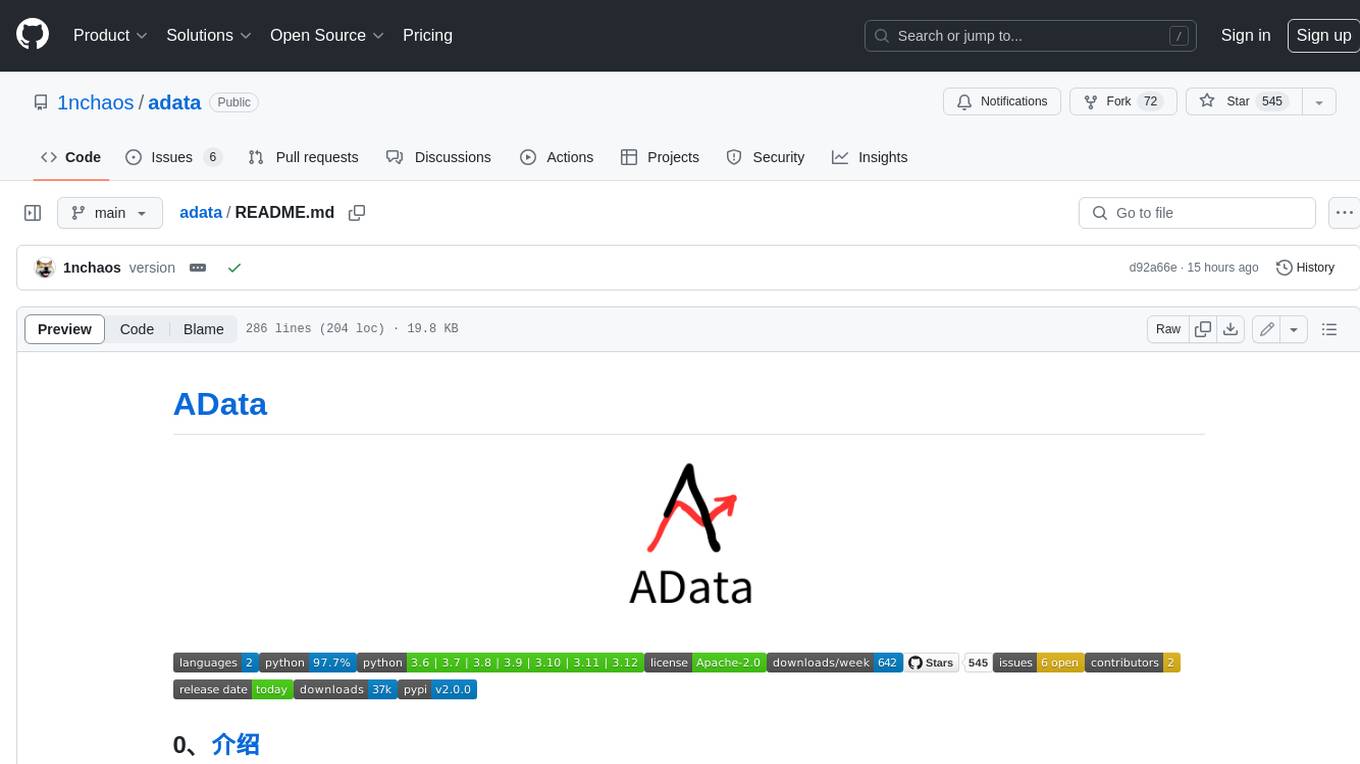
adata
AData is a free and open-source A-share database that focuses on transaction-related data. It provides comprehensive data on stocks, including basic information, market data, and sentiment analysis. AData is designed to be easy to use and integrate with other applications, making it a valuable tool for quantitative trading and AI training.
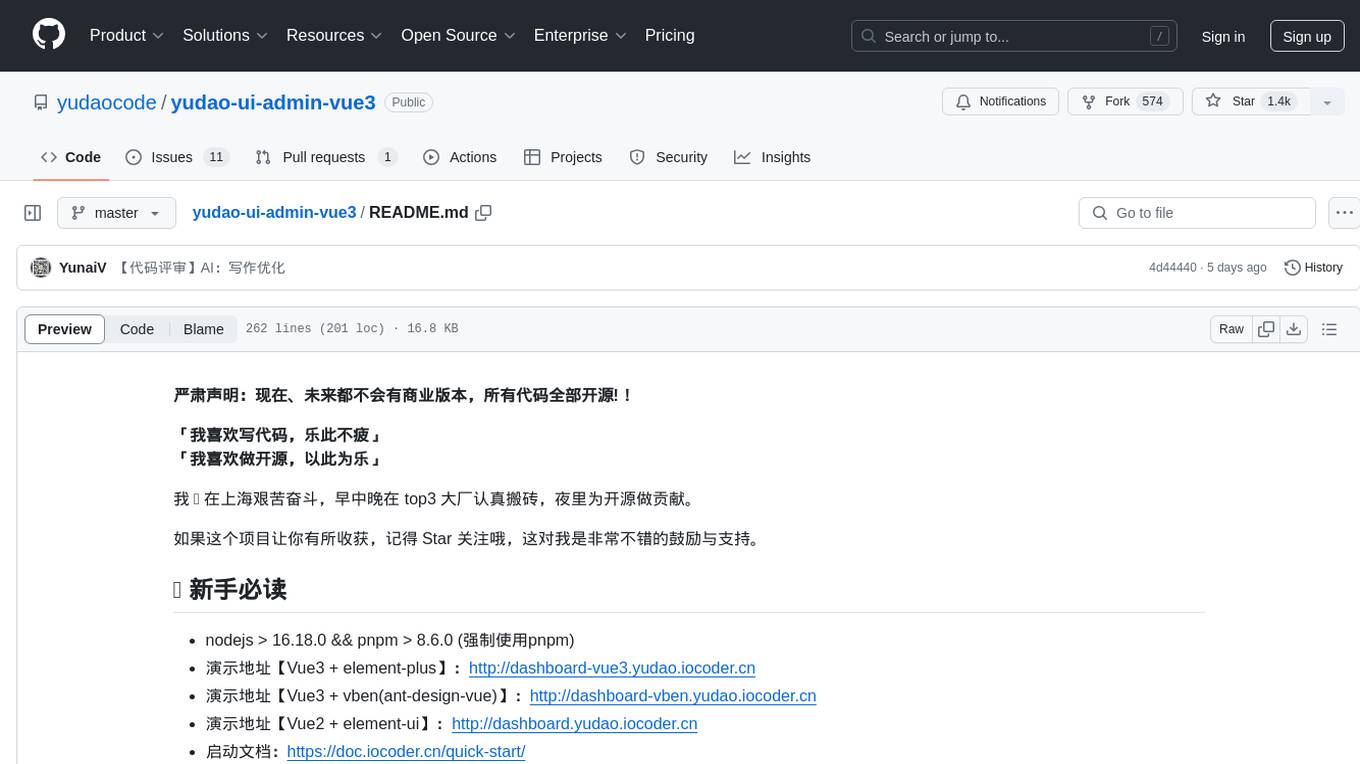
yudao-ui-admin-vue3
The yudao-ui-admin-vue3 repository is an open-source project focused on building a fast development platform for developers in China. It utilizes Vue3 and Element Plus to provide features such as configurable themes, internationalization, dynamic route permission generation, common component encapsulation, and rich examples. The project supports the latest front-end technologies like Vue3 and Vite4, and also includes tools like TypeScript, pinia, vueuse, vue-i18n, vue-router, unocss, iconify, and wangeditor. It offers a range of development tools and features for system functions, infrastructure, workflow management, payment systems, member centers, data reporting, e-commerce systems, WeChat public accounts, ERP systems, and CRM systems.

carrot
The 'carrot' repository on GitHub provides a list of free and user-friendly ChatGPT mirror sites for easy access. The repository includes sponsored sites offering various GPT models and services. Users can find and share sites, report errors, and access stable and recommended sites for ChatGPT usage. The repository also includes a detailed list of ChatGPT sites, their features, and accessibility options, making it a valuable resource for ChatGPT users seeking free and unlimited GPT services.
For similar tasks
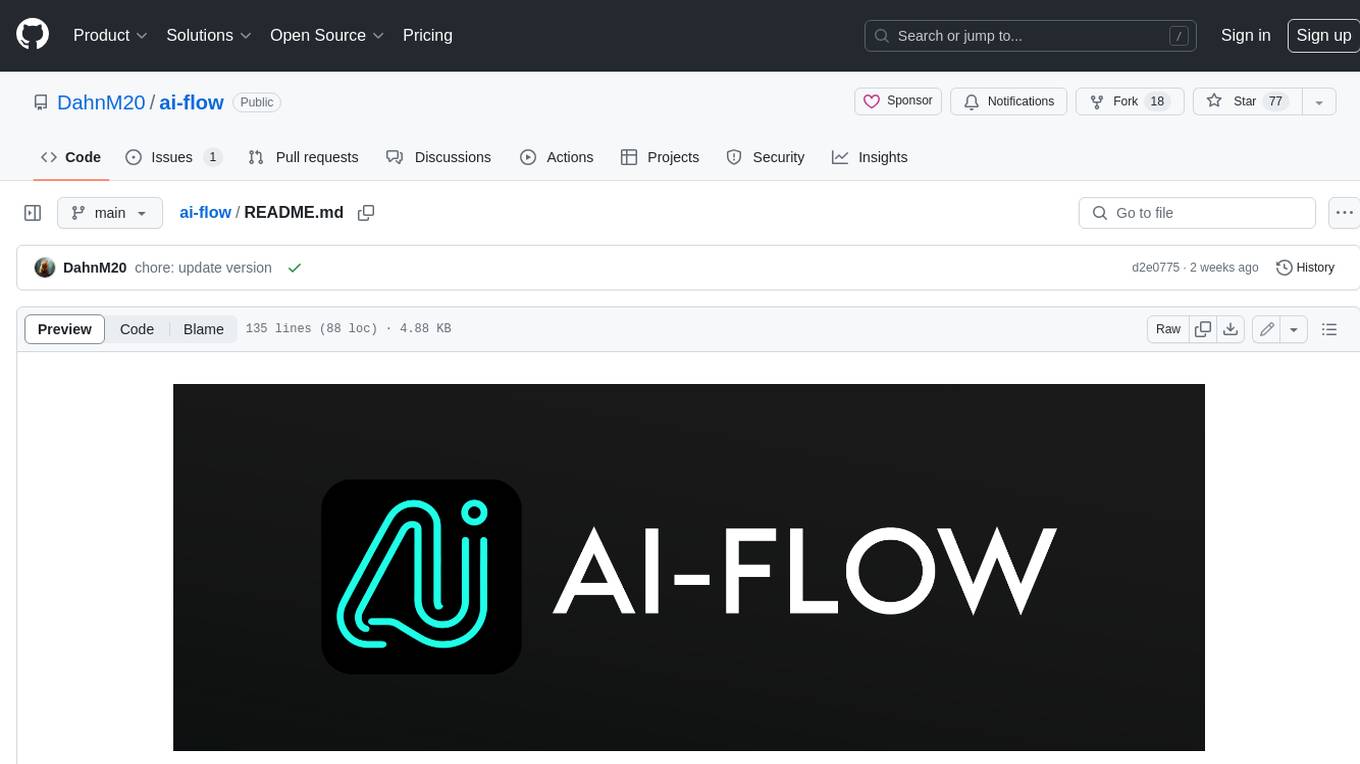
ai-flow
AI Flow is an open-source, user-friendly UI application that empowers you to seamlessly connect multiple AI models together, specifically leveraging the capabilities of multiples AI APIs such as OpenAI, StabilityAI and Replicate. In a nutshell, AI Flow provides a visual platform for crafting and managing AI-driven workflows, thereby facilitating diverse and dynamic AI interactions.
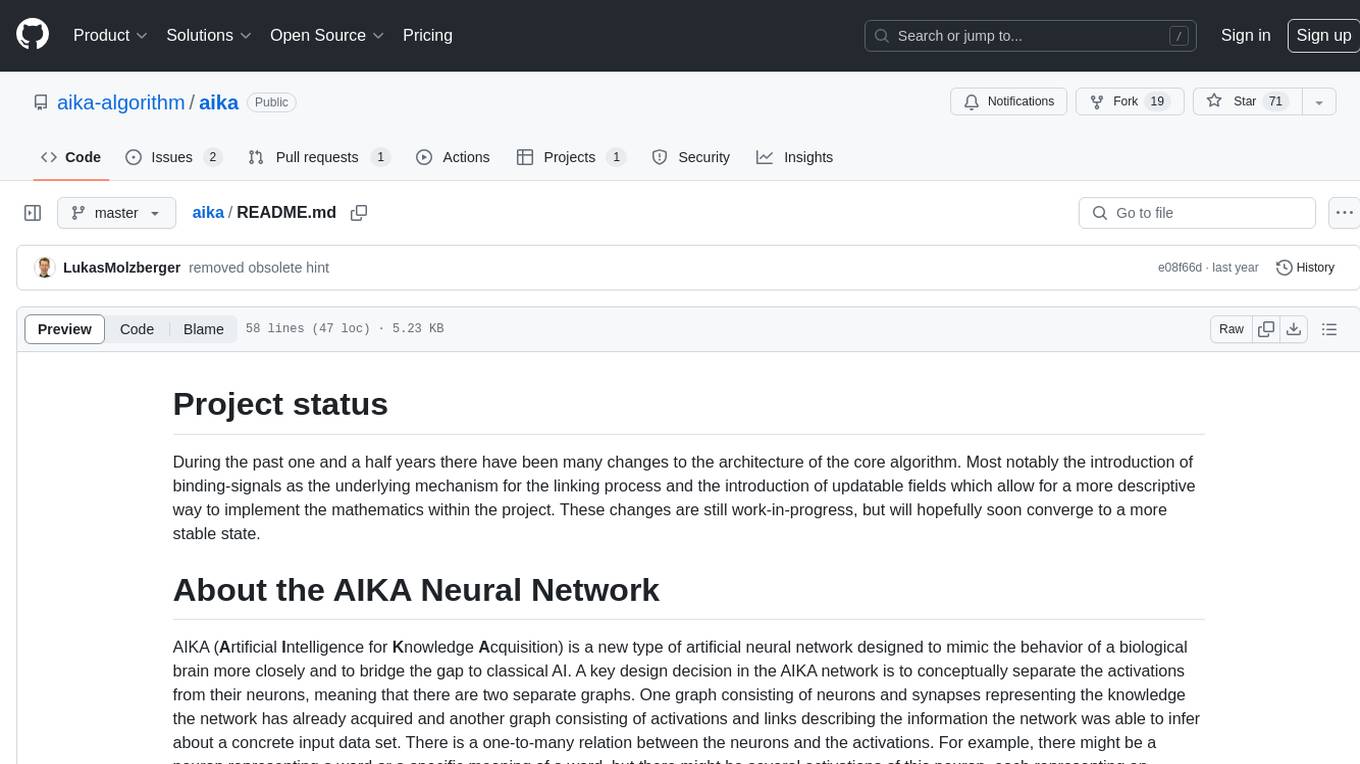
aika
AIKA (Artificial Intelligence for Knowledge Acquisition) is a new type of artificial neural network designed to mimic the behavior of a biological brain more closely and bridge the gap to classical AI. The network conceptually separates activations from neurons, creating two separate graphs to represent acquired knowledge and inferred information. It uses different types of neurons and synapses to propagate activation values, binding signals, causal relations, and training gradients. The network structure allows for flexible topology and supports the gradual population of neurons and synapses during training.
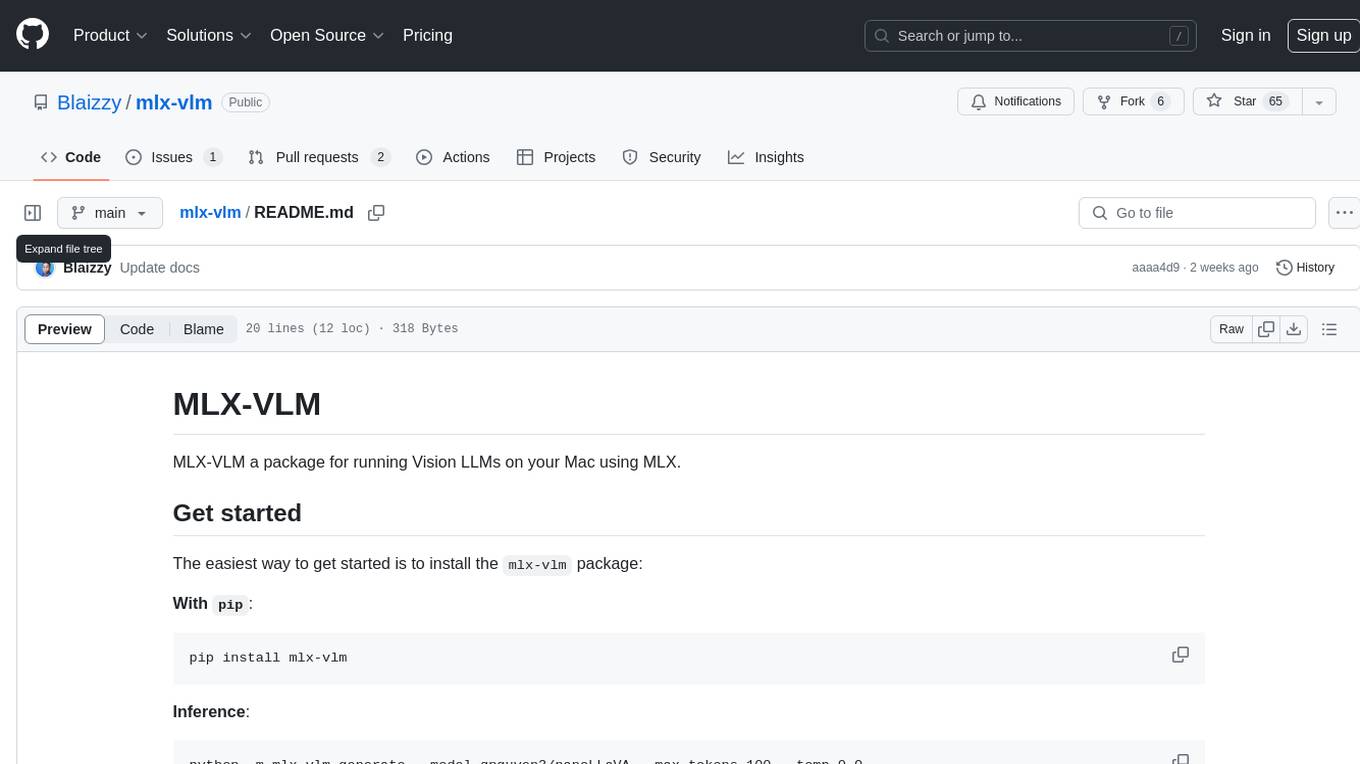
mlx-vlm
MLX-VLM is a package designed for running Vision LLMs on Mac systems using MLX. It provides a convenient way to install and utilize the package for processing large language models related to vision tasks. The tool simplifies the process of running LLMs on Mac computers, offering a seamless experience for users interested in leveraging MLX for vision-related projects.

DeepSparkHub
DeepSparkHub is a repository that curates hundreds of application algorithms and models covering various fields in AI and general computing. It supports mainstream intelligent computing scenarios in markets such as smart cities, digital individuals, healthcare, education, communication, energy, and more. The repository provides a wide range of models for tasks such as computer vision, face detection, face recognition, instance segmentation, image generation, knowledge distillation, network pruning, object detection, 3D object detection, OCR, pose estimation, self-supervised learning, semantic segmentation, super resolution, tracking, traffic forecast, GNN, HPC, methodology, multimodal, NLP, recommendation, reinforcement learning, speech recognition, speech synthesis, and 3D reconstruction.

VisionLLM
VisionLLM is a series of large language models designed for vision-centric tasks. The latest version, VisionLLM v2, is a generalist multimodal model that supports hundreds of vision-language tasks, including visual understanding, perception, and generation.
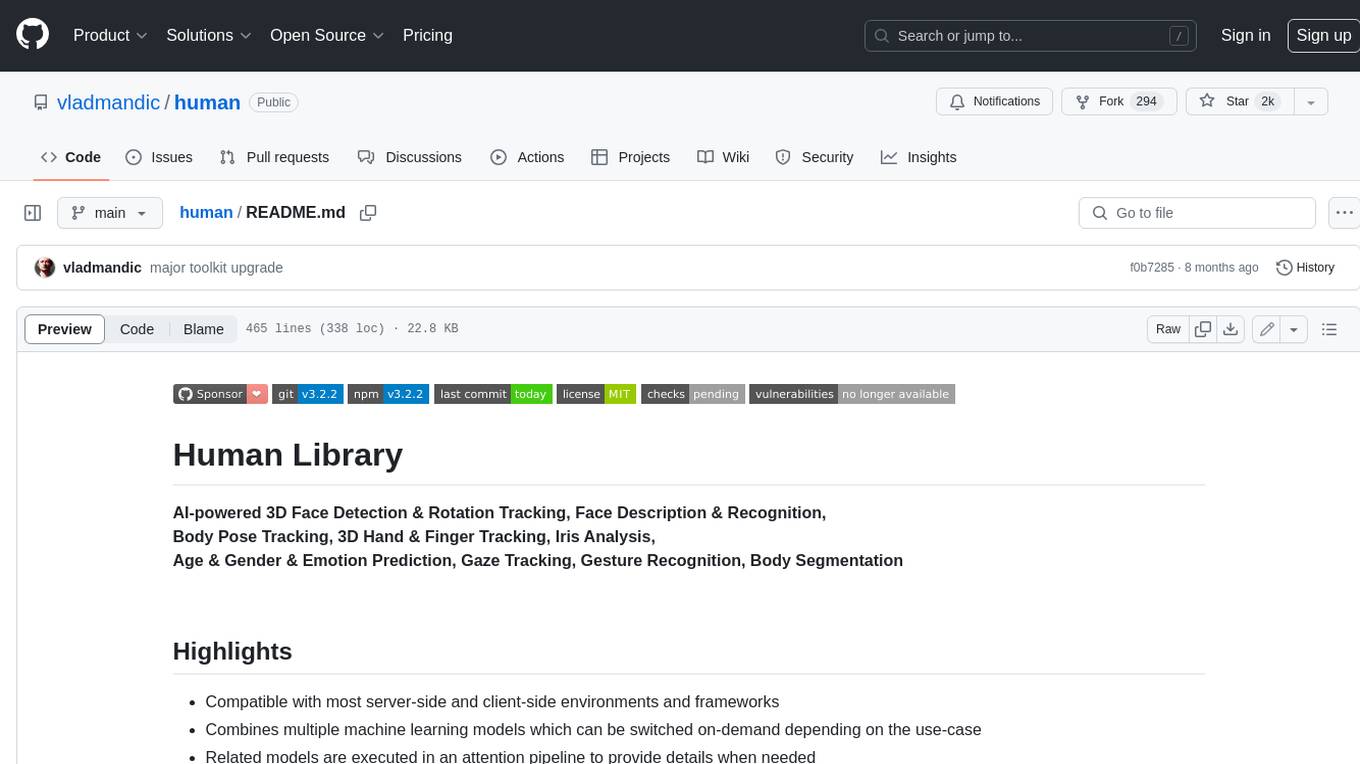
human
AI-powered 3D Face Detection & Rotation Tracking, Face Description & Recognition, Body Pose Tracking, 3D Hand & Finger Tracking, Iris Analysis, Age & Gender & Emotion Prediction, Gaze Tracking, Gesture Recognition, Body Segmentation
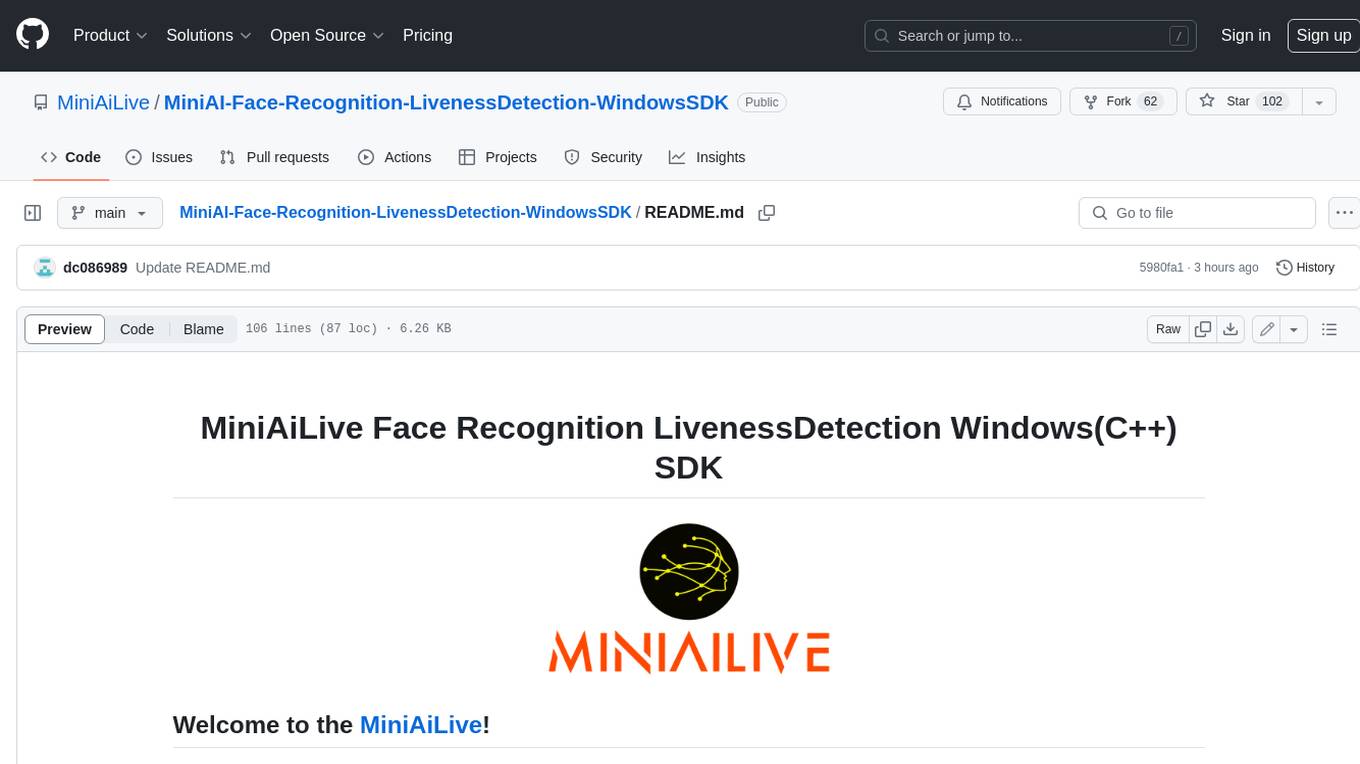
MiniAI-Face-Recognition-LivenessDetection-WindowsSDK
This repository contains a C++ application that demonstrates face recognition capabilities using computer vision techniques. The demo utilizes OpenCV and dlib libraries for efficient face detection and recognition with 3D passive face liveness detection (face anti-spoofing). Key Features: Face detection: The SDK utilizes advanced computer vision techniques to detect faces in images or video frames, enabling a wide range of applications. Face recognition: It can recognize known faces by comparing them with a pre-defined database of individuals. Age estimation: It can estimate the age of detected faces. Gender detection: It can determine the gender of detected faces. Liveness detection: It can detect whether a face is from a live person or a static image.
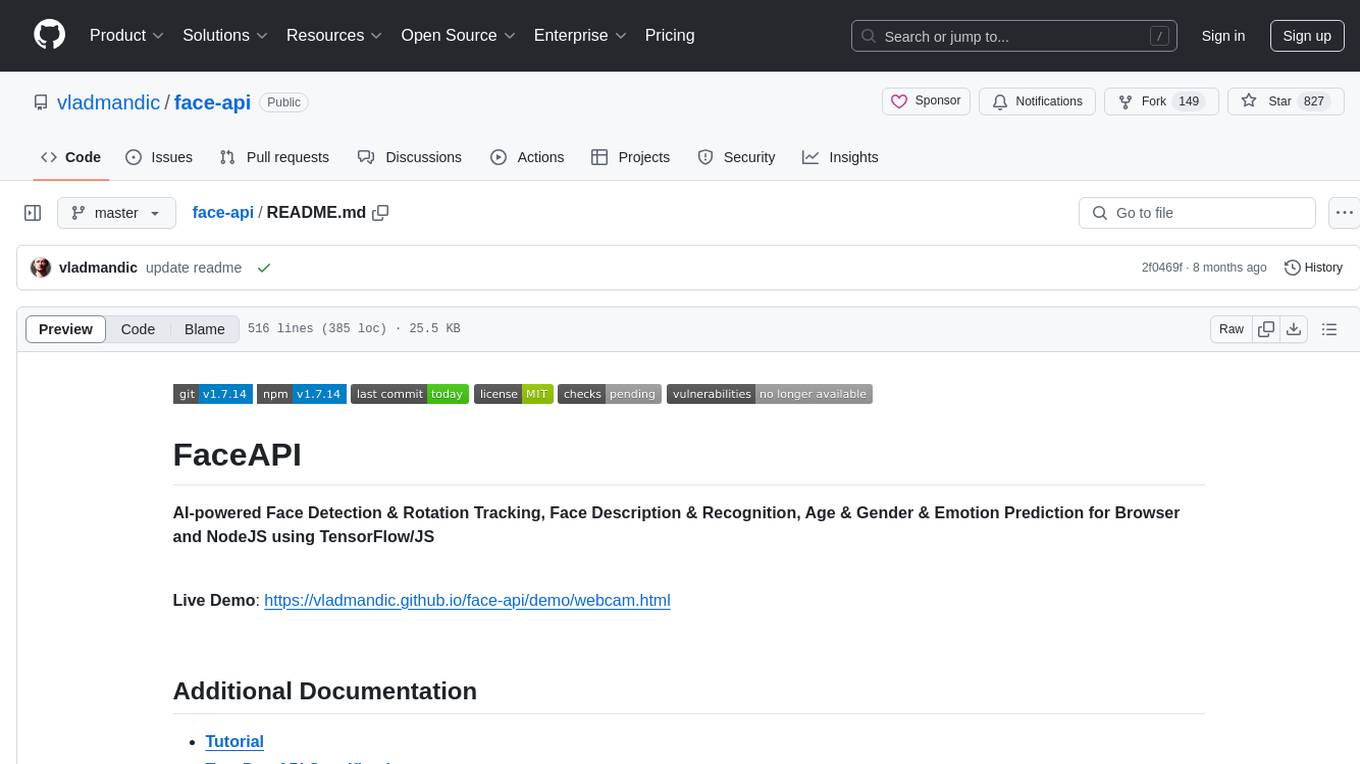
face-api
FaceAPI is an AI-powered tool for face detection, rotation tracking, face description, recognition, age, gender, and emotion prediction. It can be used in both browser and NodeJS environments using TensorFlow/JS. The tool provides live demos for processing images and webcam feeds, along with NodeJS examples for various tasks such as face similarity comparison and multiprocessing. FaceAPI offers different pre-built versions for client-side browser execution and server-side NodeJS execution, with or without TFJS pre-bundled. It is compatible with TFJS 2.0+ and TFJS 3.0+.
For similar jobs

weave
Weave is a toolkit for developing Generative AI applications, built by Weights & Biases. With Weave, you can log and debug language model inputs, outputs, and traces; build rigorous, apples-to-apples evaluations for language model use cases; and organize all the information generated across the LLM workflow, from experimentation to evaluations to production. Weave aims to bring rigor, best-practices, and composability to the inherently experimental process of developing Generative AI software, without introducing cognitive overhead.

LLMStack
LLMStack is a no-code platform for building generative AI agents, workflows, and chatbots. It allows users to connect their own data, internal tools, and GPT-powered models without any coding experience. LLMStack can be deployed to the cloud or on-premise and can be accessed via HTTP API or triggered from Slack or Discord.

VisionCraft
The VisionCraft API is a free API for using over 100 different AI models. From images to sound.

kaito
Kaito is an operator that automates the AI/ML inference model deployment in a Kubernetes cluster. It manages large model files using container images, avoids tuning deployment parameters to fit GPU hardware by providing preset configurations, auto-provisions GPU nodes based on model requirements, and hosts large model images in the public Microsoft Container Registry (MCR) if the license allows. Using Kaito, the workflow of onboarding large AI inference models in Kubernetes is largely simplified.

PyRIT
PyRIT is an open access automation framework designed to empower security professionals and ML engineers to red team foundation models and their applications. It automates AI Red Teaming tasks to allow operators to focus on more complicated and time-consuming tasks and can also identify security harms such as misuse (e.g., malware generation, jailbreaking), and privacy harms (e.g., identity theft). The goal is to allow researchers to have a baseline of how well their model and entire inference pipeline is doing against different harm categories and to be able to compare that baseline to future iterations of their model. This allows them to have empirical data on how well their model is doing today, and detect any degradation of performance based on future improvements.

tabby
Tabby is a self-hosted AI coding assistant, offering an open-source and on-premises alternative to GitHub Copilot. It boasts several key features: * Self-contained, with no need for a DBMS or cloud service. * OpenAPI interface, easy to integrate with existing infrastructure (e.g Cloud IDE). * Supports consumer-grade GPUs.

spear
SPEAR (Simulator for Photorealistic Embodied AI Research) is a powerful tool for training embodied agents. It features 300 unique virtual indoor environments with 2,566 unique rooms and 17,234 unique objects that can be manipulated individually. Each environment is designed by a professional artist and features detailed geometry, photorealistic materials, and a unique floor plan and object layout. SPEAR is implemented as Unreal Engine assets and provides an OpenAI Gym interface for interacting with the environments via Python.

Magick
Magick is a groundbreaking visual AIDE (Artificial Intelligence Development Environment) for no-code data pipelines and multimodal agents. Magick can connect to other services and comes with nodes and templates well-suited for intelligent agents, chatbots, complex reasoning systems and realistic characters.





